Welcome to the third and final release of 2019, TimeTrak 19.3.
In this version, we have some exciting new features and settings along with many new user-friendly features.
Please browse through this document to find out more.
Contents
1. Show Budget and Remaining Totals
In previous versions of TimeTrak within TimeTrak Professional, on the time entry form the job budget (and task budget if tasks are enabled) can be seen as per below:

In TimeTrak version 19.3, the below additional profile setting has been added to control user’s ability to see this information.
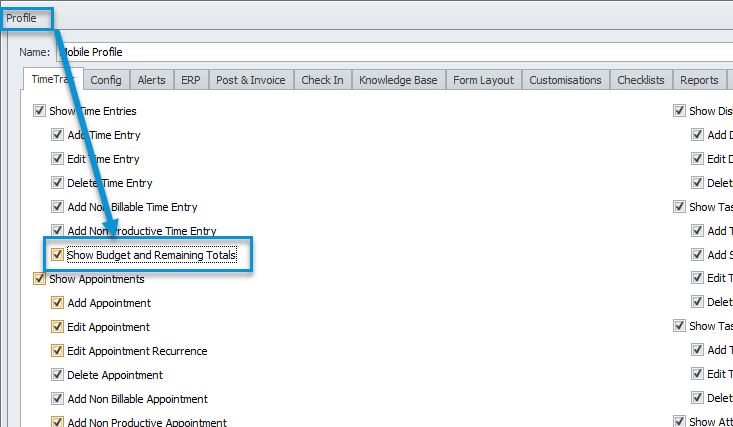
This Profile setting also determines if this information is visible within TimeTrak Mobile where it was previously not available. As per below the budget and remaining totals are displayed as a floating tool bar in Mobile on the time entry form.
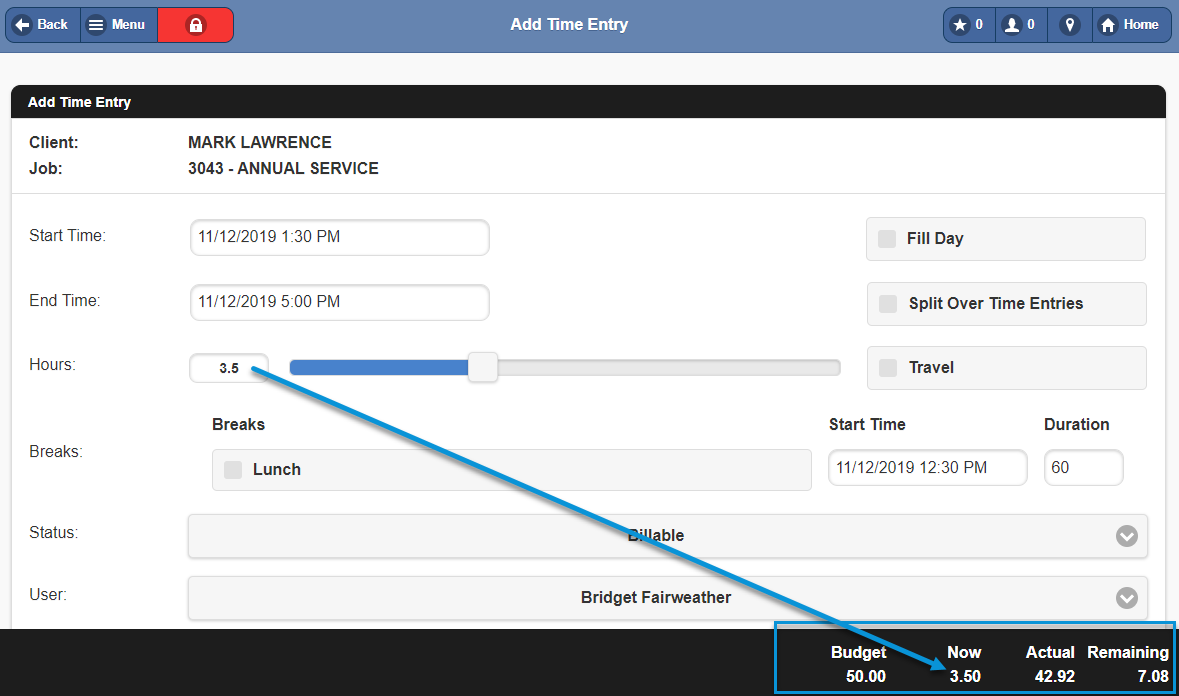
Budget = Total quantity of all quote lines against the job where the copy to field is set to “T” (Time)

Now = Value of the current time entry being added.
Actual = Value of the sum of all time against the job in ERP which is WIP, or ready to invoice + the sum of all time against the job in TimeTrak which when posted to the job will land as WIP or ready to invoice.
Remaining = Value of Budget – Now – Actual
This information also flows through for users who are adding time for multiple users at once as per below:
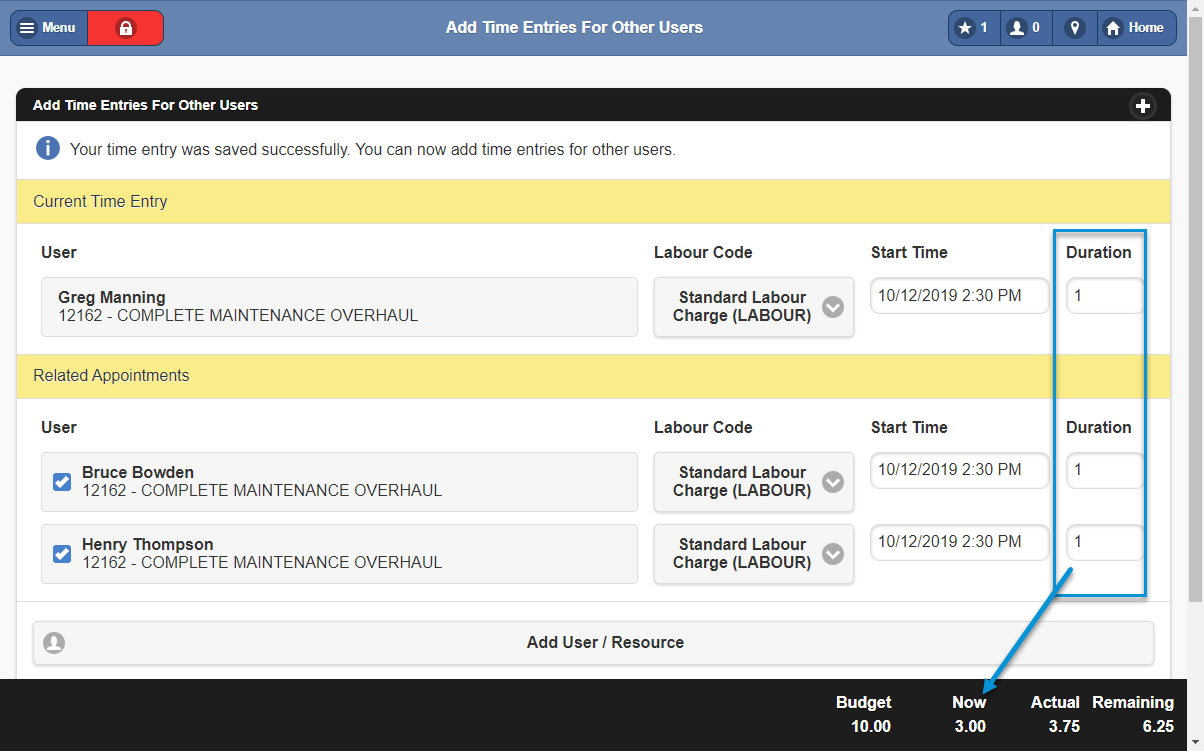
This is a useful feature for field staff recording time to ensure they are aware of how much budget is remaining on the job so appropriate actions such as notifying the client or internal project manager that the project may go over budget.
2. Job Budget Includes Appointments
Previously in TimeTrak, budget calculations have included appointments in the remaining calculation.
See below example from 19.2, when the job has both a 1-hour time entry and a 1-hour appointment the remaining budget is reduced by both the time entry and appointment.

In 19.3, the below global system setting has been added:
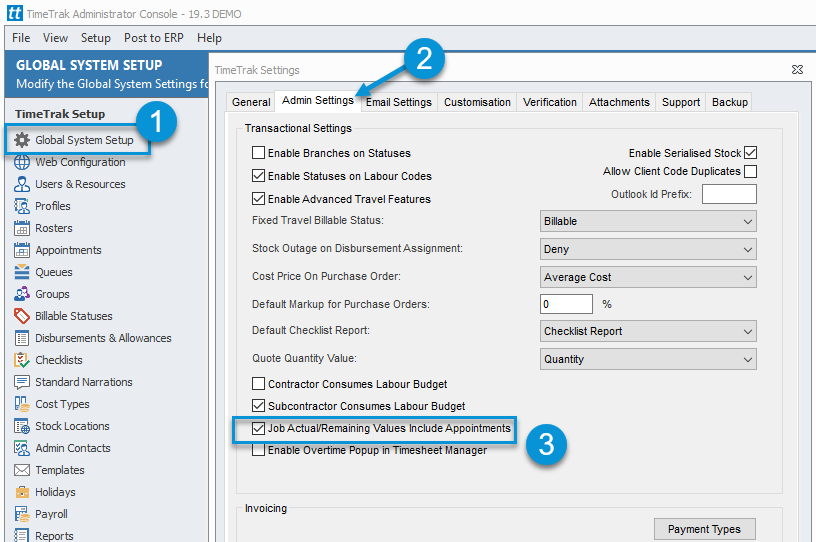
If “Job Actual/Remaining Values include Appointments” is enabled the behaviour to 19.2 is still applicable.
However, if the setting is not enabled, then as per below only time entries that hit the job as WIP or Ready to Invoice reduce the budget of the job as scheduled appointments are not included.

This feature provides the ability for businesses to decide at a global level if appointments should be included in the job actual/ remaining values.
3.Team Leaders can now see their time entry on the “Add Time Entries for other users” screen in Mobile.
In team scheduling environments when a team leader saves their time entry and goes “Save & Manage Other Users / Resources” as per below:
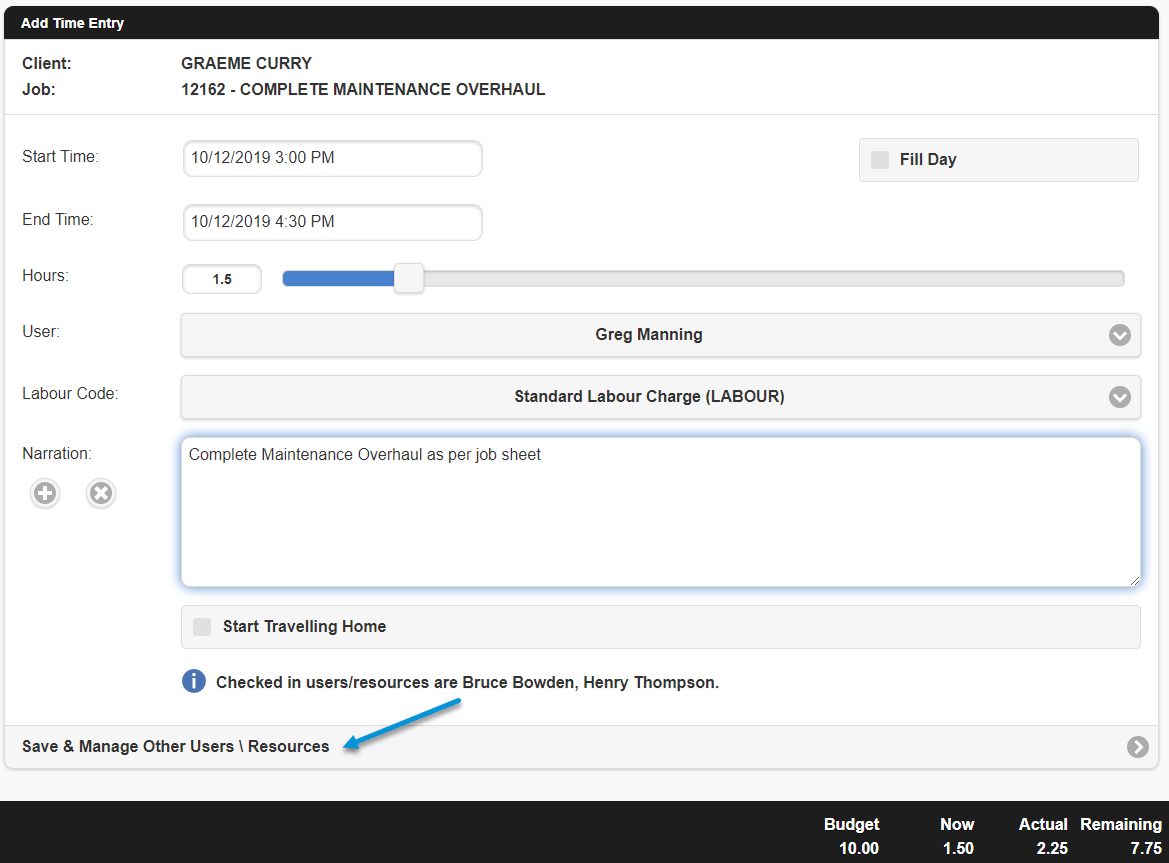
Previously, users were unable to see or alter the time entry they had just created for themselves within this screen.
As per below, in 19.3 the time entry that has just been created can be reviewed/ altered from this screen also:
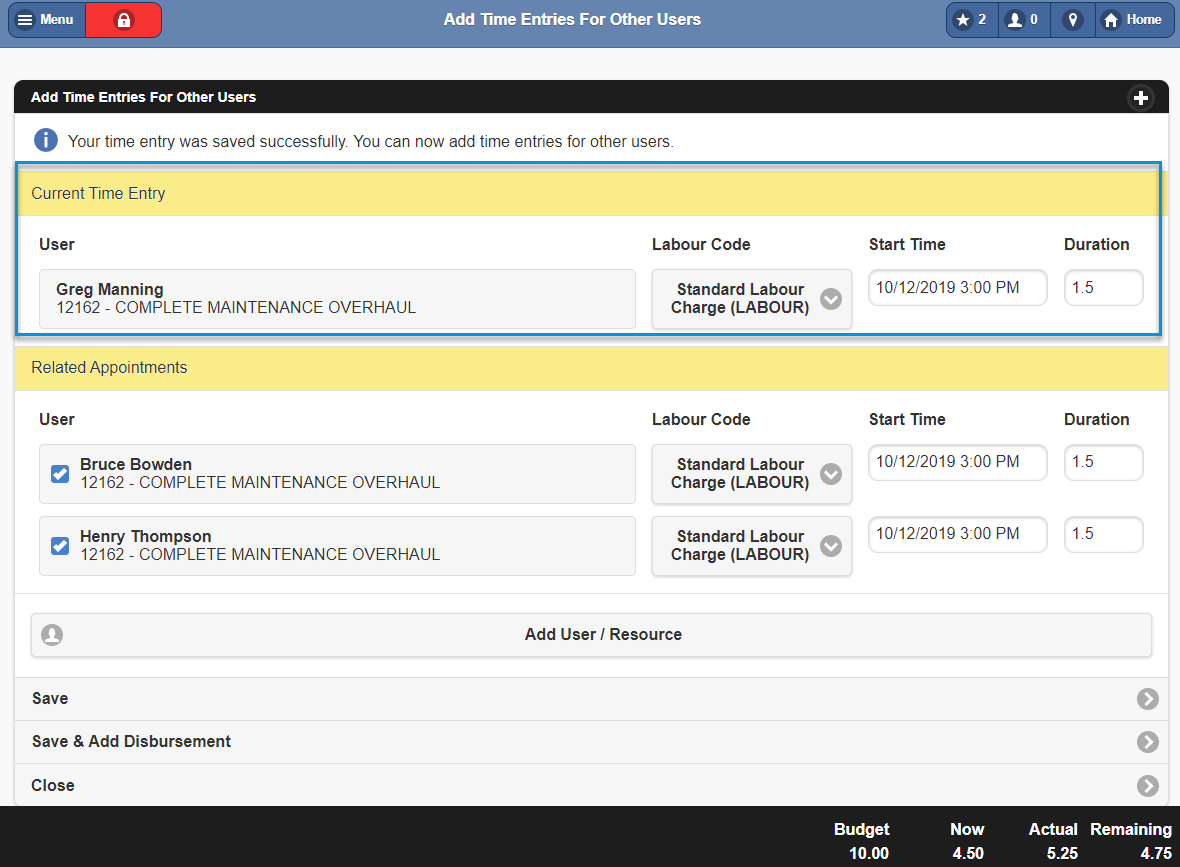
This feature along with the ability to see the budget is useful for team based field staff working to budgets.
4. Unpaid Breaks within TimeTrak
Previously in TimeTrak, unpaid breaks such as lunch breaks were left as unscheduled time or setup as breaks, which are unable to be adjusted on a day-to-day basis.
This can be confusing visually, especially to Mobile users where the lunch break is not moved if lunch is taken at a different time.
See below example of a previous version (19.2):
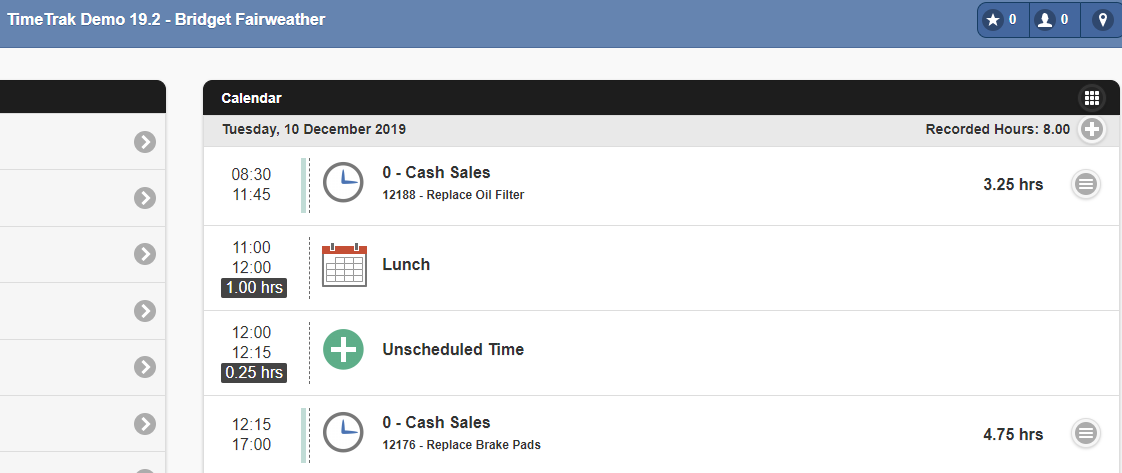
In TimeTrak, from version 19.3 breaks have been moved to user rosters and can be assigned a time analysis code and recorded on a daily basis without export to payroll or reporting being affected.
The display of this is also much more user friendly as per below:
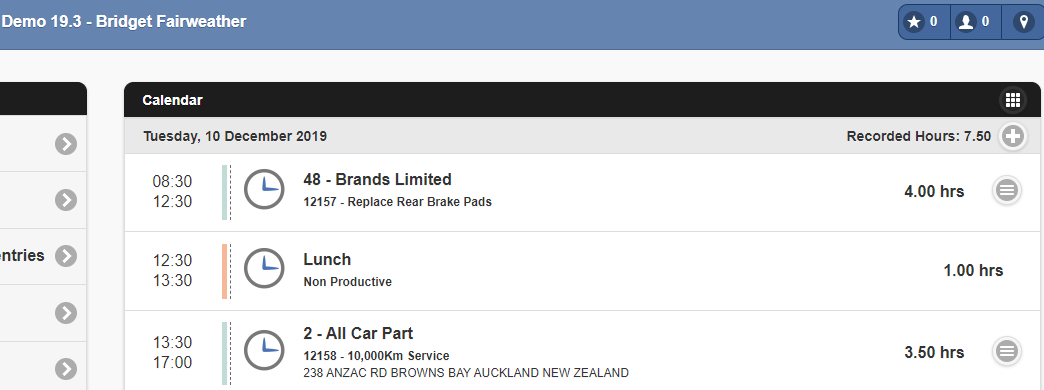
For more information on Unpaid Breaks in TimeTrak, click here.
5. Uncommitted Schedule/Draft Appointments
TimeTrak 19.3 introduces an ability to create uncommitted appointments in TimeTrak Professional.
Uncommitted appointments have been designed to assist schedulers “draft” appointment allocation without providing Mobile users the ability to see what has been assigned to them until the appointments are “committed” or confirmed.
Uncommitted appointments will display with grey stripes as per the below screen.
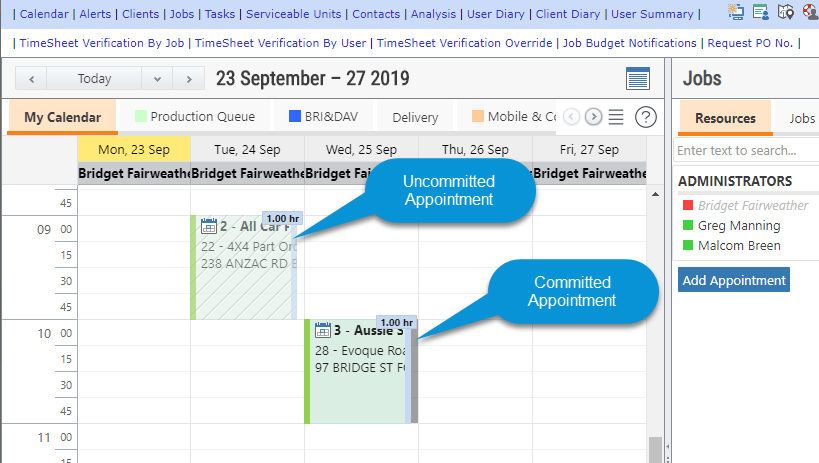
To activate this feature, enable “Allow Uncommitted Appointments” against the schedulers profile as per below:

If the above option is enabled, the below “Save as Uncommitted” tick box will appear on the new appointment form enabled by default:
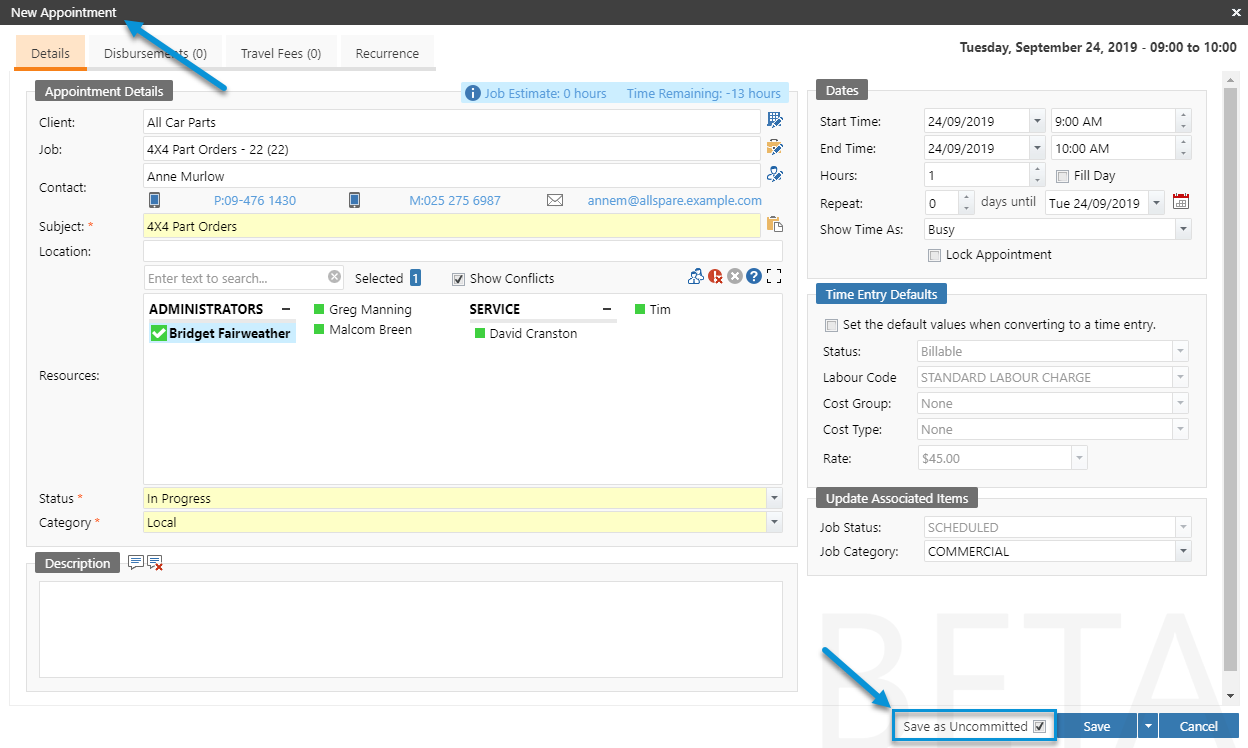
In this example, Bridget is the scheduler and David is field staff with TimeTrak Mobile access. Bridget created multiple uncommitted appointments for David whilst she works through bookings and confirms with clients.
Bridget can right click a single uncommitted appointment > “Change State” to “Committed” which will then be visible in David’s calendar.
Alternatively, once Bridget is happy with the schedule she can right click in the workgroup/ calendar view in Professional and select “Commit Appointment”, which will commit all uncommitted appointments in the selected workgroup/ calendar view.
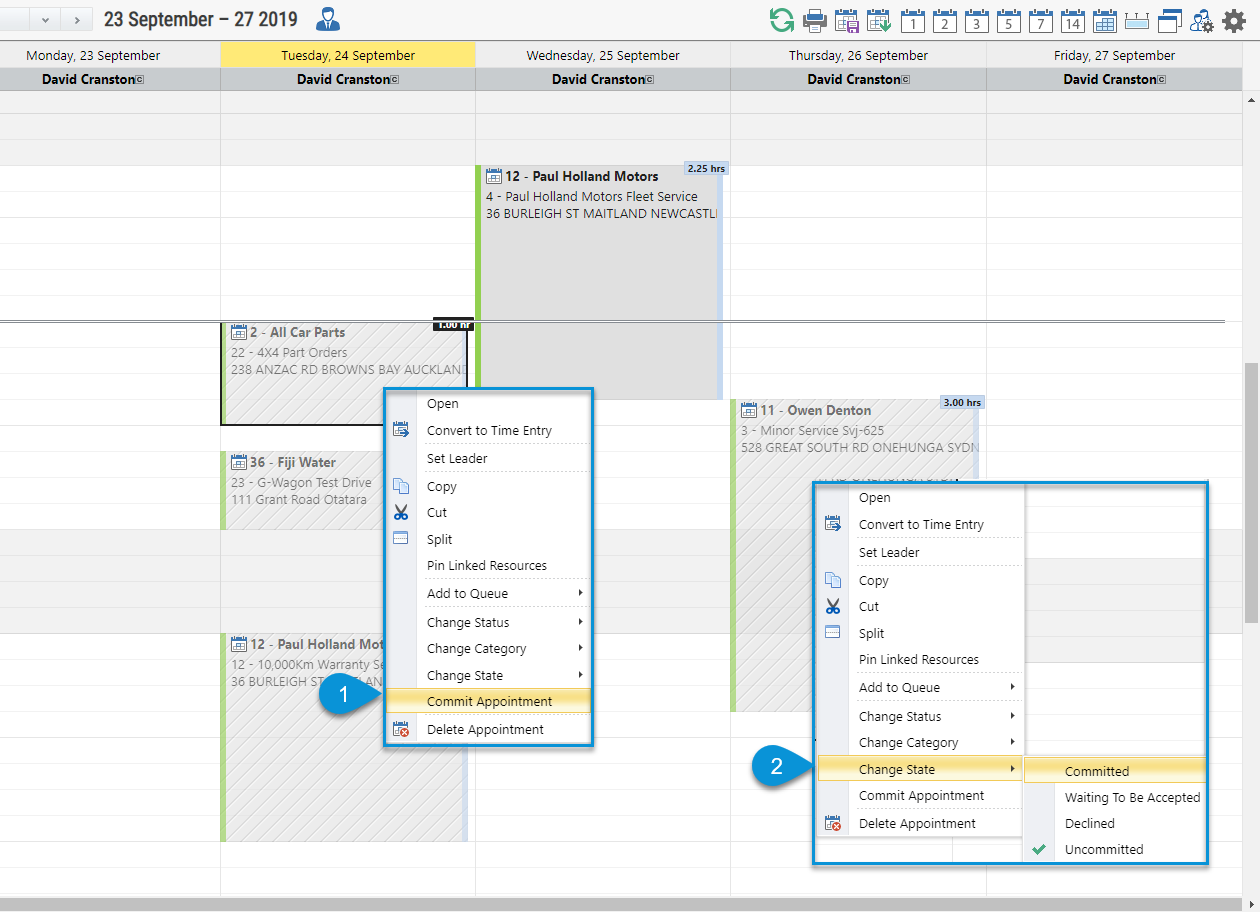
The process of committing appointments can be an automated process via a scheduled event setup in the TimeTrak Administrator Console to prevent the need for scheduling staff to do this manually.
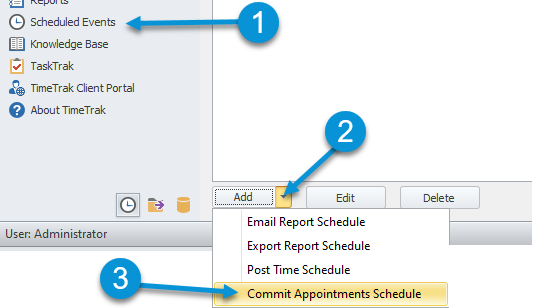
Uncommitted appointments are only visible to Bridget and committed appointments are now visible to David as per the below screen.
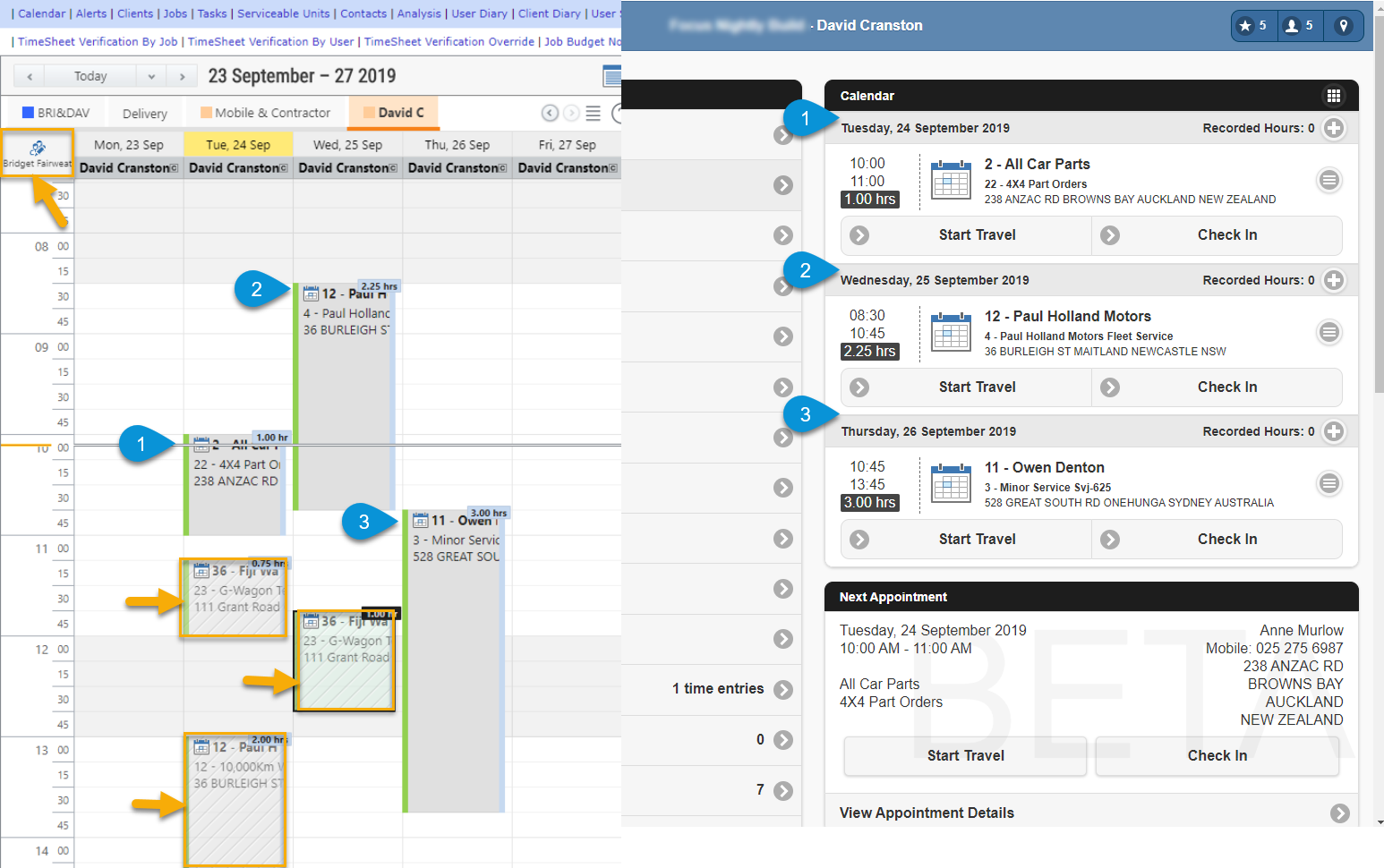
For more information on Uncommitted appointments in TimeTrak click here.
6. Appointment Acceptance
In TimeTrak 19.3 appointment acceptance has been enhanced to further streamline this process.
If “Enable Appointment Acceptance” is enabled on user profiles as per below:
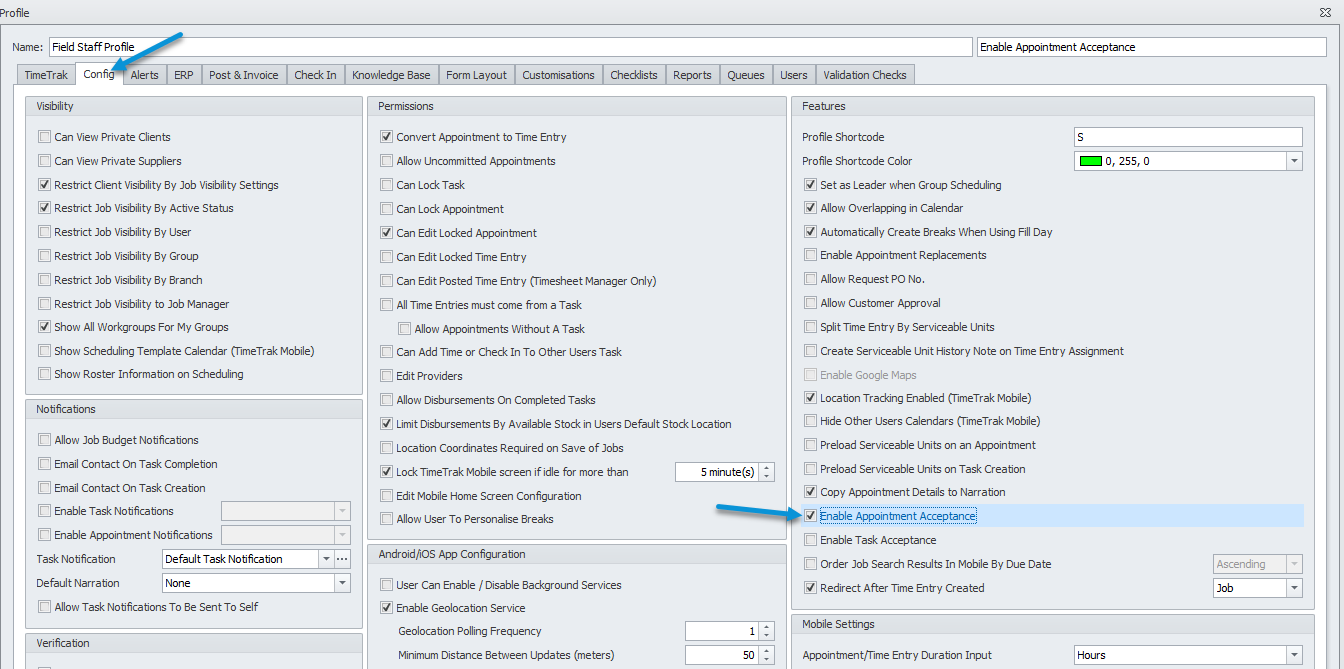
When a user against this profile is assigned an appointment, they are required to accept this.
In 19.3, a legend has been added to the Professional website to display what each icon/ colour represents against both appointments and time entries.
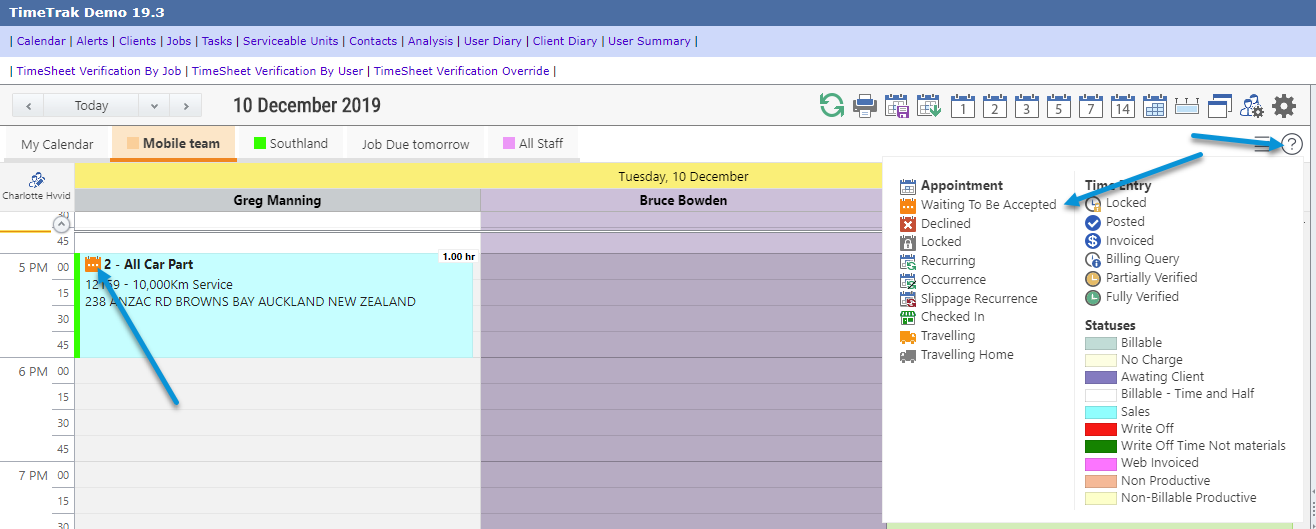
In TimeTrak Mobile, Greg can then accept or decline on an appointment basis or “accept day’s appointments” as per below:
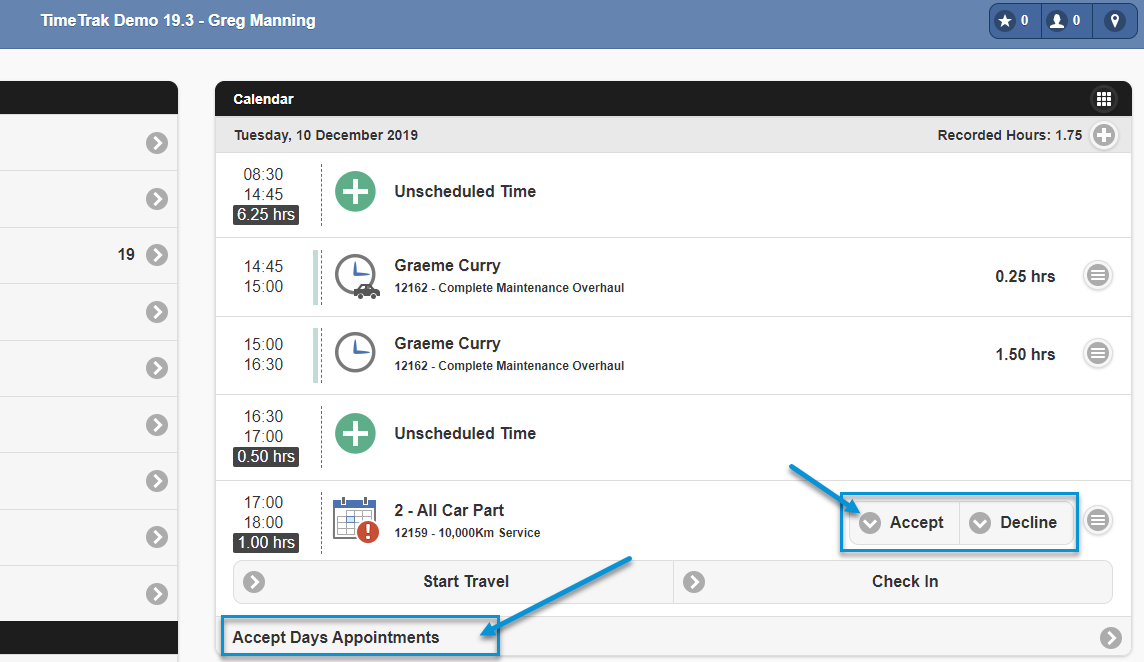
If the appointment is declined, the user will be prompted to add the reason for declining it.
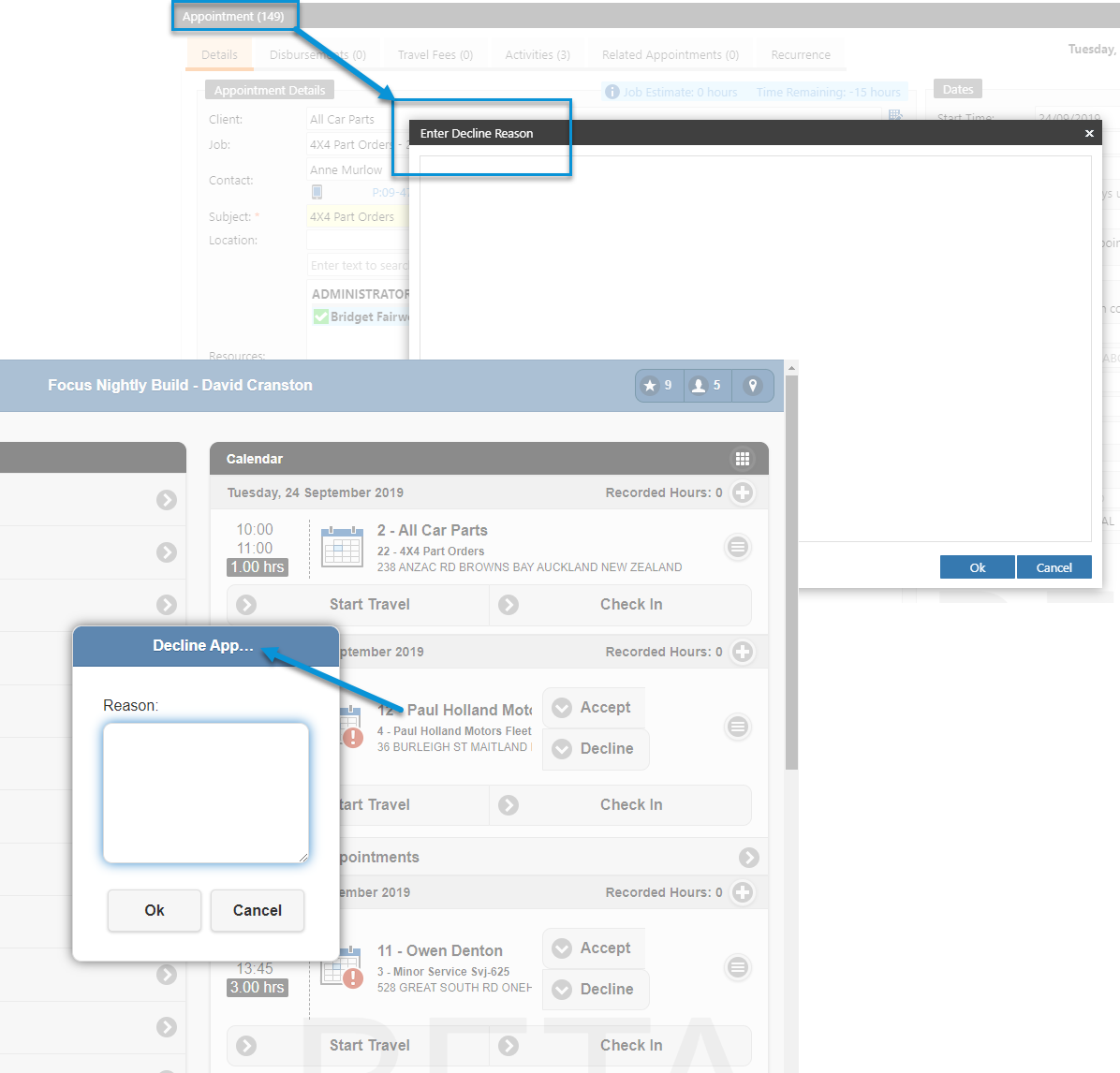
The appointment will then be removed from the TimeTrak Mobile. However, it will be still visible on TimeTrak Professional as an inactive appointment as shown in below screen.
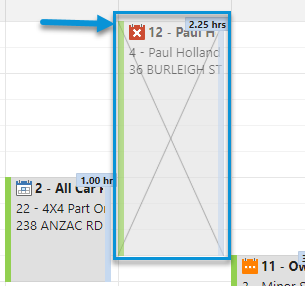
Email notification to appointment scheduler will be sent and the appointment activities will be updated with the reason and other related information.
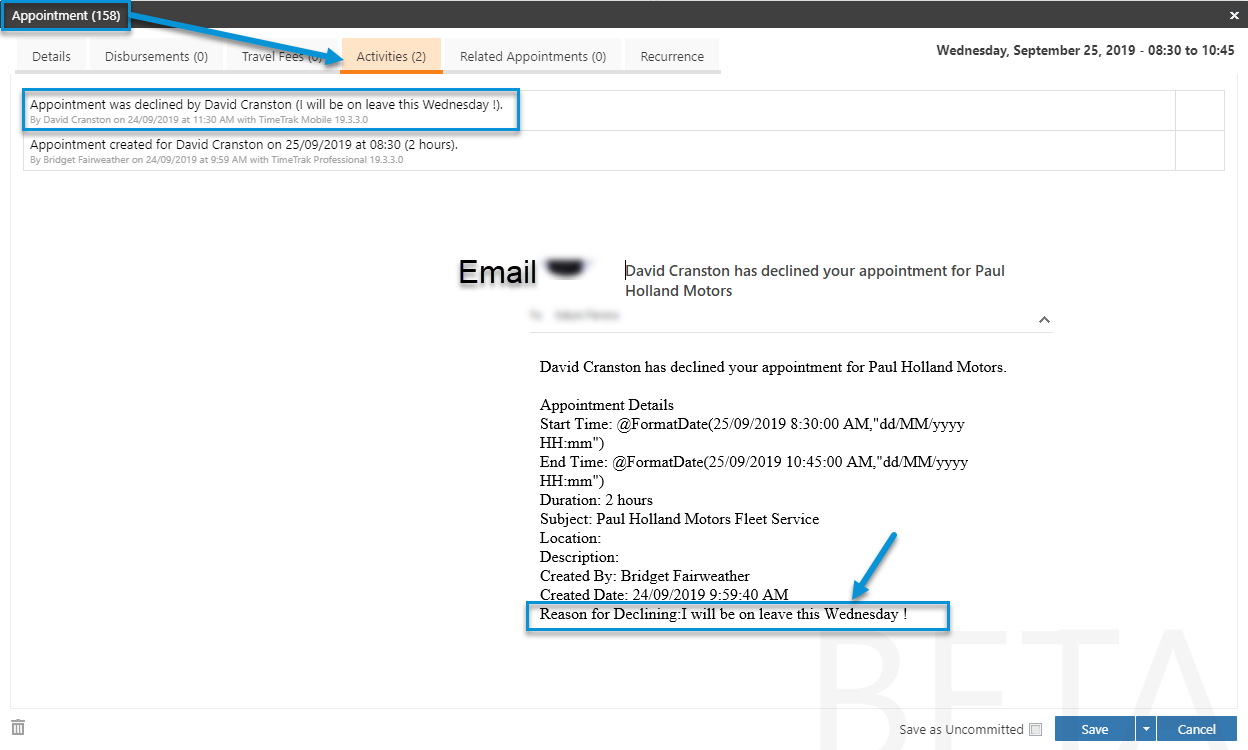
For more information on appointment acceptance in TimeTrak, click here.
7. Remove automated queues from the right click
Queues within TimeTrak can be either Manual or Automated.
Manual = Display data manually put there by a user.
Automated = Display data populated automatically on a set frequency that matches set criteria in the database.
In Previous versions of TimeTrak, the entire list of visible queues for the user was available via the right click “Move to” option as well as the “Save and Add to Queue” option.
This caused issues if users manually added items to an automated queue which then cleared these out and on refresh and only added what was specified.
In 19.3, only manual queues visible to the user will be available in the right click “Move to” option as well as the “Save and Add to Queue” option.
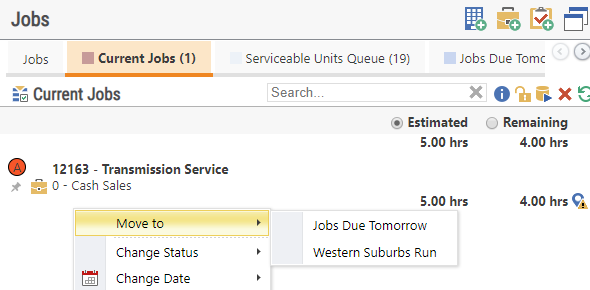
The use of Serviceable Units within TimeTrak is drastically varied depending on business processes.
To assist with this, “Serviceable Unit” is now available on the profile form layout against:
Appointment, Disbursement, Quote Line and Time Entry.
This provides the ability to hide the serviceable unit selection against all of the above options if serviceable units should not be assigned to these as part of the company’s business processes.
Continuing with this, in form layout there is also a serviceable unit form section, which provides the ability to hide fields, which are not applicable to business processes:
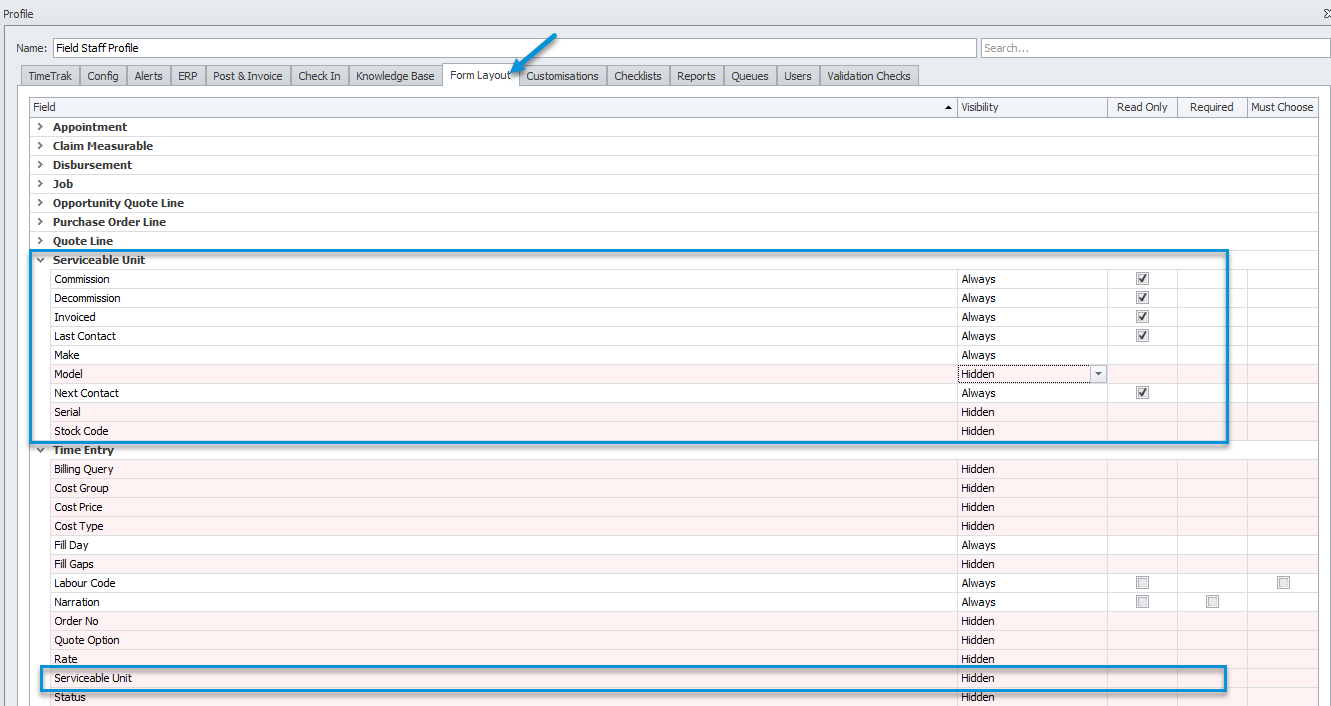
Please note: Commission, Decommission, Invoiced, Last Contact and Next Contact dates are only available by default in TimeTrak Professional. These will need to be added as custom fields to display in Mobile if required.
In TimeTrak 19.3, the beginning of a job form layout has been added against profiles with Contact and Notes fields available as per below:

This profiles the ability for Job Notes to be visible or hidden on a profile basis as well as the ability to make job contact a required field.
10. Profile setting to edit job notes only in Mobile
Continuing with permissions around job notes, in 19.3 there is an additional profile setting as per below to control whether a mobile user has the ability to edit job notes.
If the users profile has “Edit Job” enabled, then sub settings “Edit job notes” and “Edit Job Status” will be enabled by default as per below:
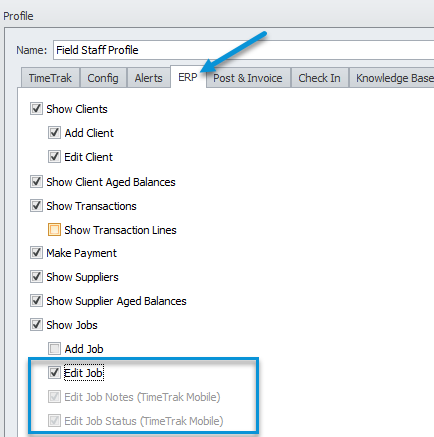
However, if Mobile users assigned to the profile do not have the ability to edit the job they can have the ability to edit only the job notes by enabling “Edit Job Notes (TimeTrak Mobile) as per below:
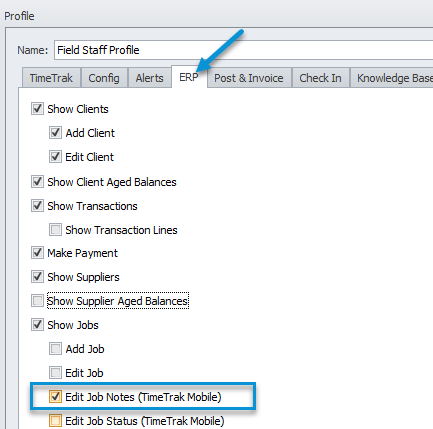
Once enabled, this will display to the Mobile user as per below:
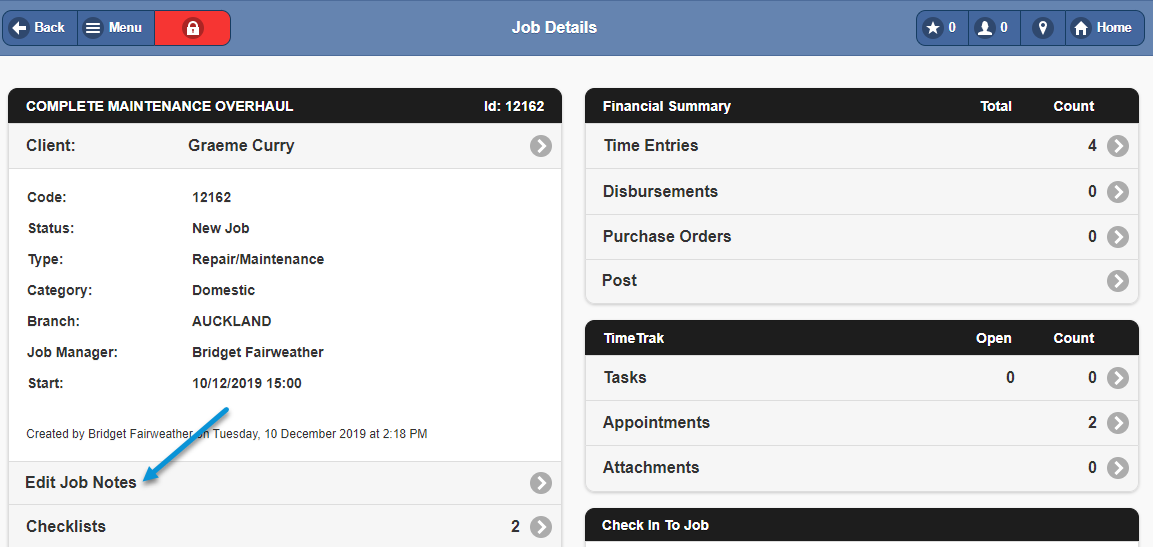
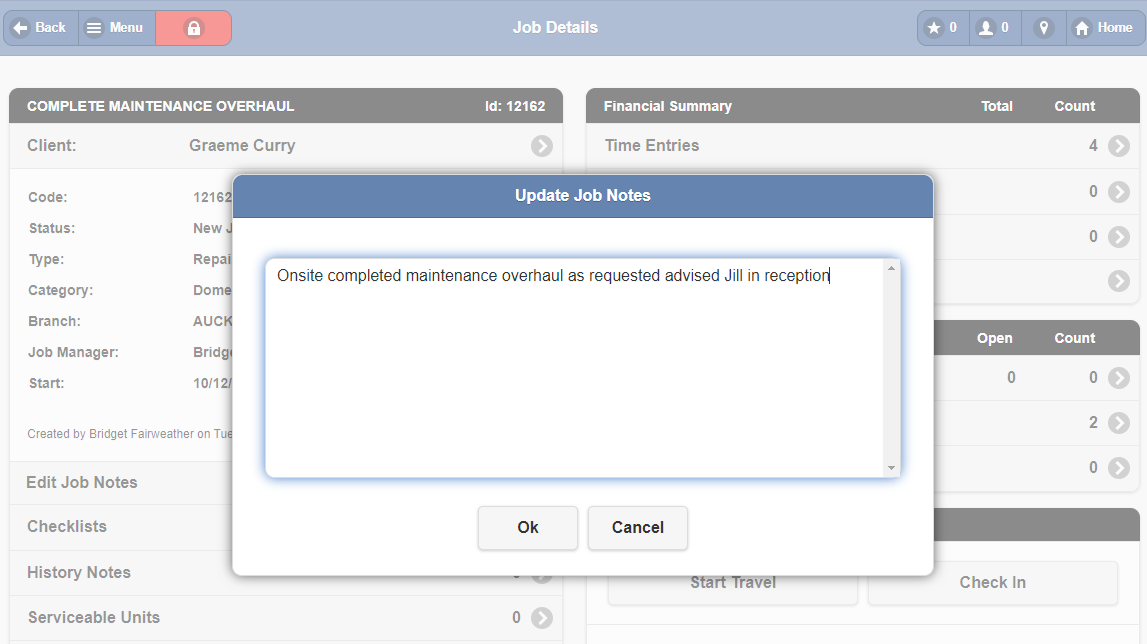
For more information on providing the ability for Mobile users to edit the job status only, click here.
11. Allow users with different Time Setting to co-exist on the same workgroup
In previous versions of TimeTrak, users who did not have the same time unit settings were unable to be displayed in the same workgroup view within TimeTrak Professional.
In 19.3, users who have different time units can be displayed in the same workgroup – the user will be warned but not prevented from saving the workgroup.
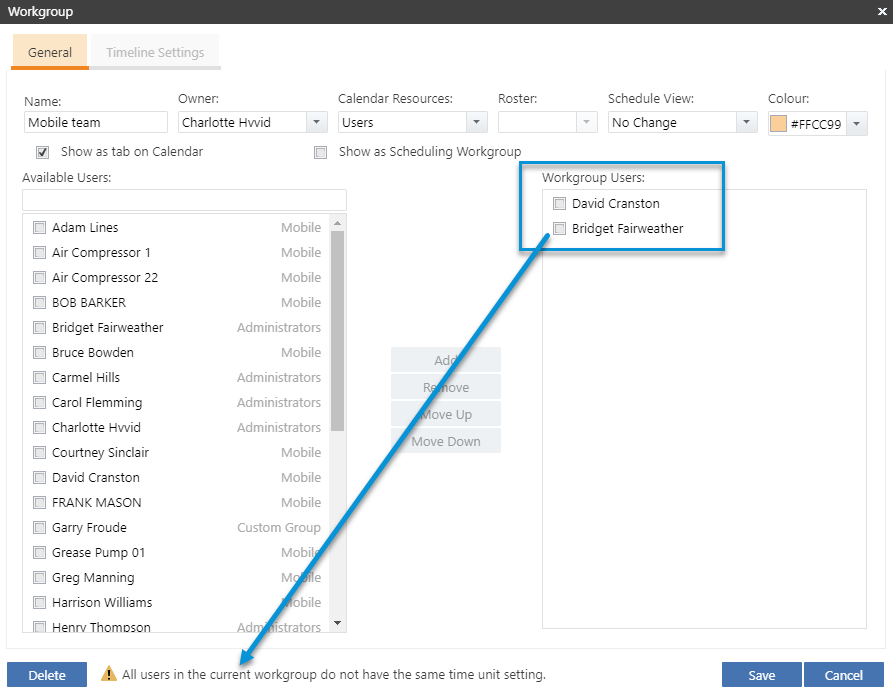
This is useful for environments where users have different time units but management would like to review their calendars in one workgroup.
12. Currency field has been moved to the top of the client form in TimeTrak Professional
In previous versions of TimeTrak the client (debtor), currency was located at the bottom of the form which in some environments caused debtors to be setup with the incorrect currency value.
In 19.3 the currency field has been moved to the top of the form as per below to make the field stand out more.
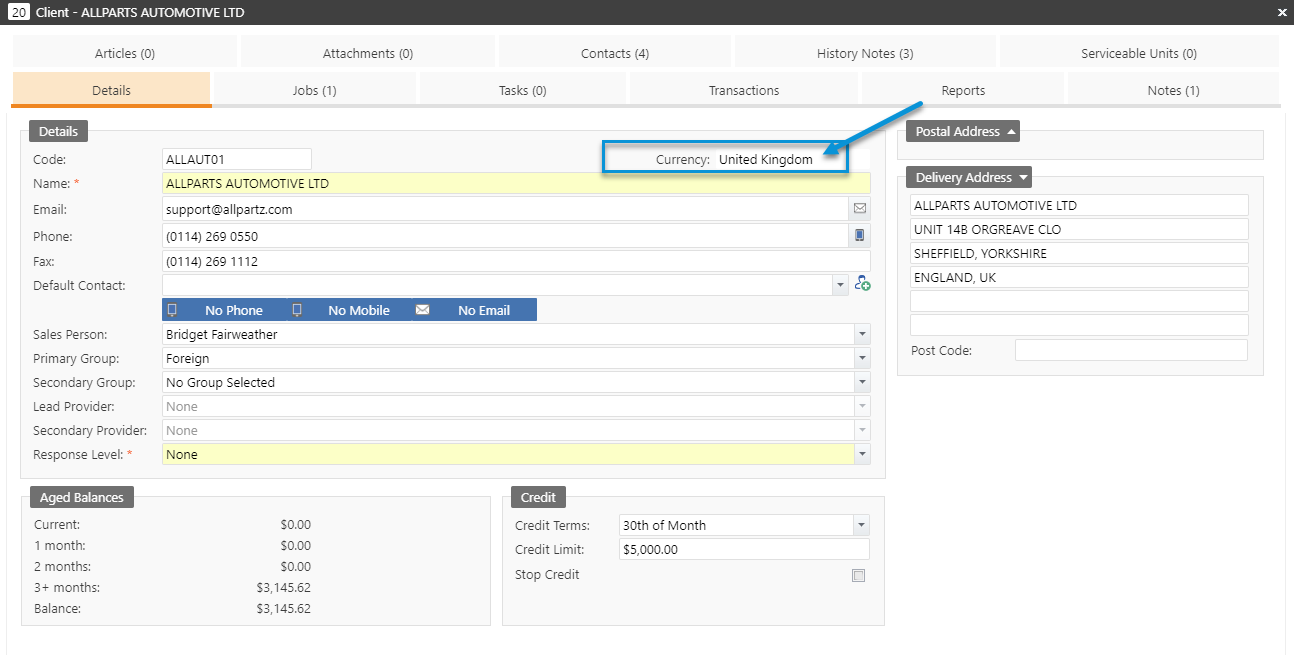
13. Job status update history to job activities
To further enhance the job activities table that was added in version 19.2, in TimeTrak version 19.3 every time a job’s status is updated the date, who made the change and where the change was made will be recorded to the jobs activities tab as per below:
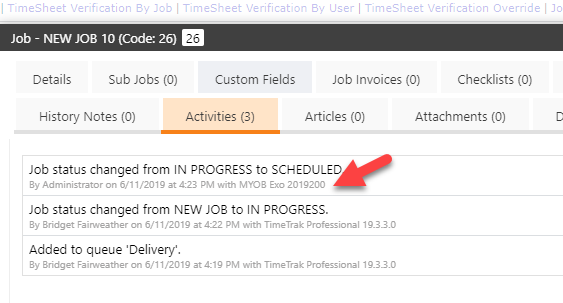
14. TimeTrak Job Templates now visible in Professional
TimeTrak uses Job Templates to speed up the creation of jobs within TimeTrak.
Previously these jobs needed to be managed in the ERP system as they were not visible in TimeTrak.
For information on Job Templates in TimeTrak click here.
In TimeTrak 19.3, there is the added ability to display and manage TimeTrak Job Templates in Professional if the below profile, setting “Show Job Templates Tab” is enabled:
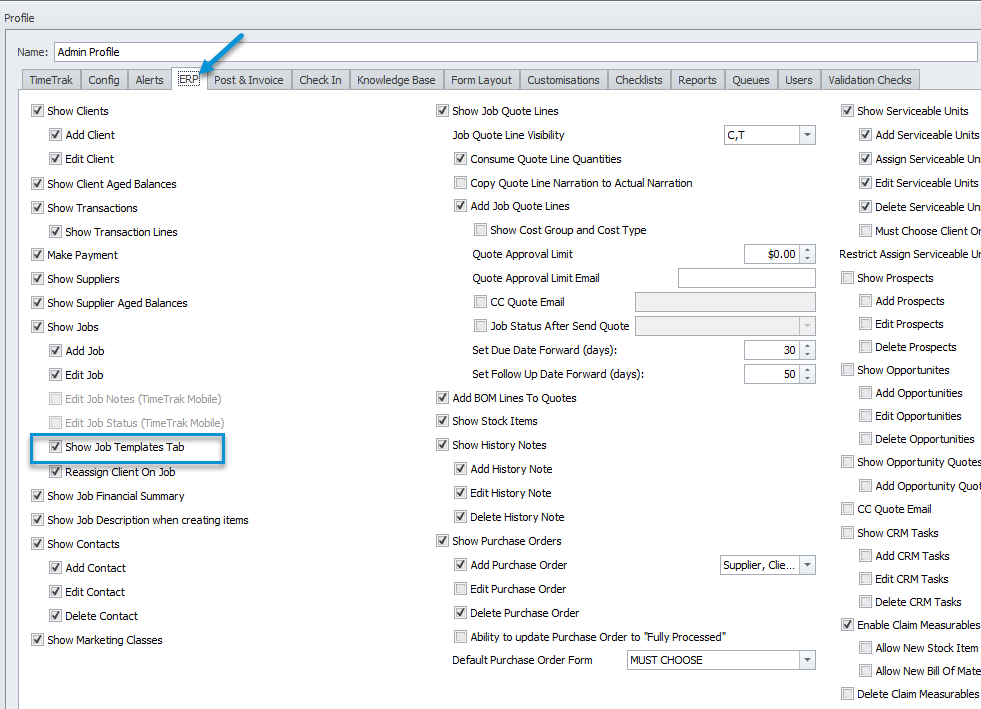
Once enabled, users assigned against this profile will see a “Job Templates” tab within TimeTrak Professional as per below.
This tab will display all jobs where “TimeTrak Template” is enabled and template jobs can be managed accordingly.
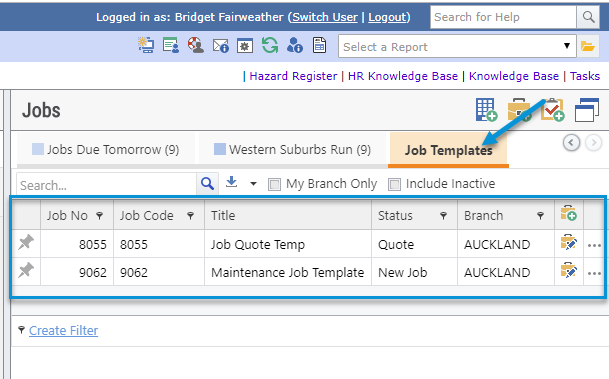
15. Custom fields set against job templates pull through to new jobs on creation.
In previous versions of TimeTrak, if custom fields were set to “read only” and specified against the job template they would not pull through to corresponding jobs created via that template.
In 19.3, any custom field set against the job template will pull through to corresponding jobs created via the template job.
16. Adding Trusted IP addresses to the Two Factor Authentication settings
In version 19.2, there was many enhancements around security including the ability to setup two factor authentication within TimeTrak.
For more information on two factor authentication in TimeTrak click here.
In 19.2, there was a setting “Ignore two-factor authentication for local requests” where TimeTrak had hardcoded “local requests” to be within the below IP ranges:
10.0.0.0 to 10.255.255.255
172.16.0.0 to 172.31.255.255
192.168.0.0 to 192.168.255.255
Due to different IT environments, in TimeTrak version 19.3 the setting “Ignore two-factor authentication for local requests” has been replaced with “Ignore two-factor authentication for trusted requests” and there is now the ability to setup “Trusted IP’s” with the hardcoded “local request” IP ranges removed providing further flexibility for different IT environments.
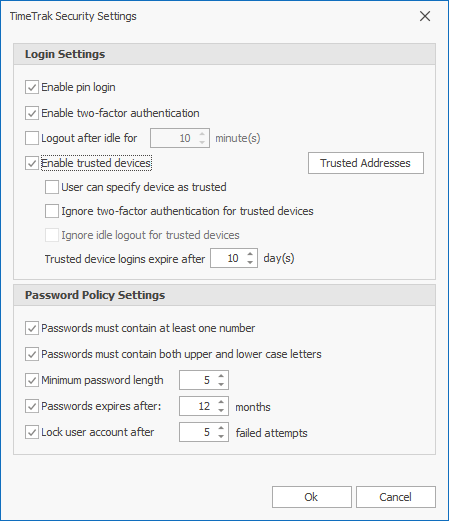
There is also the additional setting “User can specify device as trusted”.
If a user accesses TimeTrak via a device outside of the trusted addresses and this setting is enabled, they will be able to mark their device as “trusted” when logging in.
TimeTrak will then remember their login credentials and they will not need to authenticate each day on logging in (similar to the remember me function).
If this setting is not enabled and the user accesses TimeTrak on a device outside of the trusted Addresses they will not be able to use the remember me function and will be required to enter their login credentials and authenticate each time they access the website.
17. Search for help added to TimeTrak Professional and the TimeTrak Administrator Console.
In previous versions of TimeTrak, there has been some emphasis on providing the ability for end users to manage users and profiles within TimeTrak easier.
As part of this, a search function was added to profiles within the TimeTrak Administrator Console to allow end users to search profile settings.
Tool tips, which cover what the setting does, as well as links to relevant content on our website were also added.
Continuing with this, in 19.3 with in the TimeTrak Administrator console there is a search function as per below which allows users to search for help
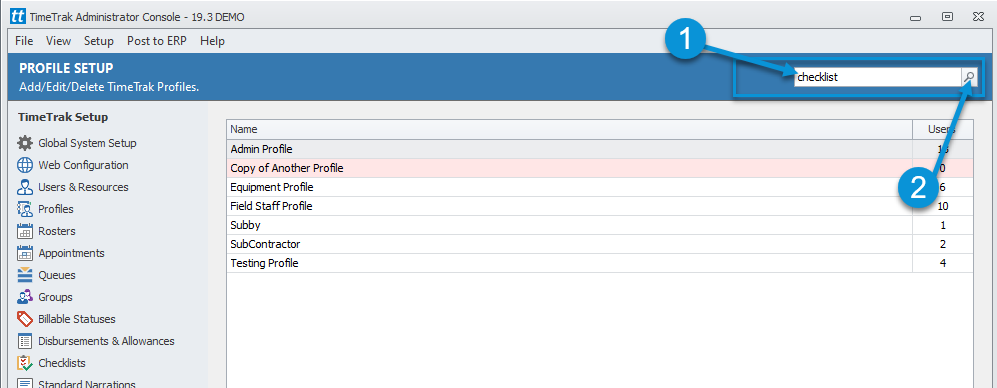
On clicking of the magnifying glass icon the users default browser will open in the TimeTrak website referencing blog articles, whitepapers and tips of the week that relate to the searched item:
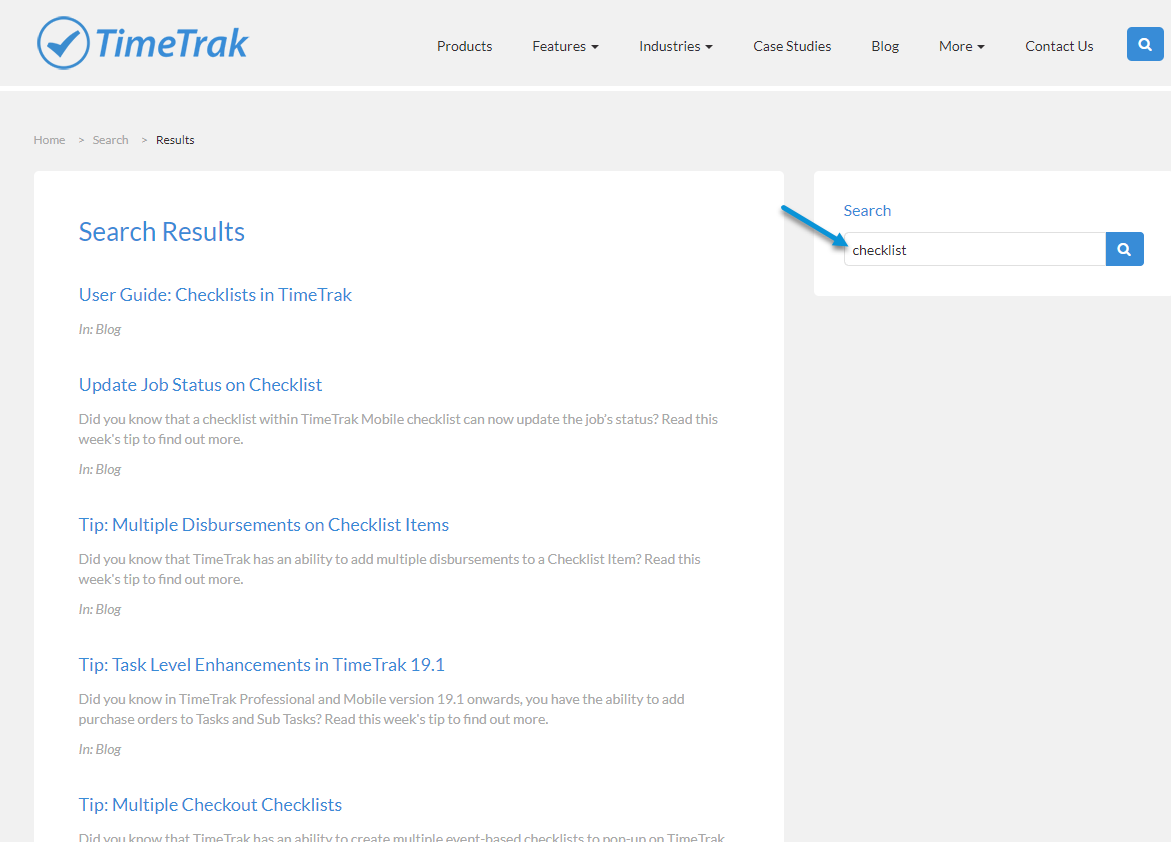
The same functionality has also been add to the TimeTrak Professional website as per below:

Which will open the TimeTrak website within the calendar panel with the results for the searched content as per below:
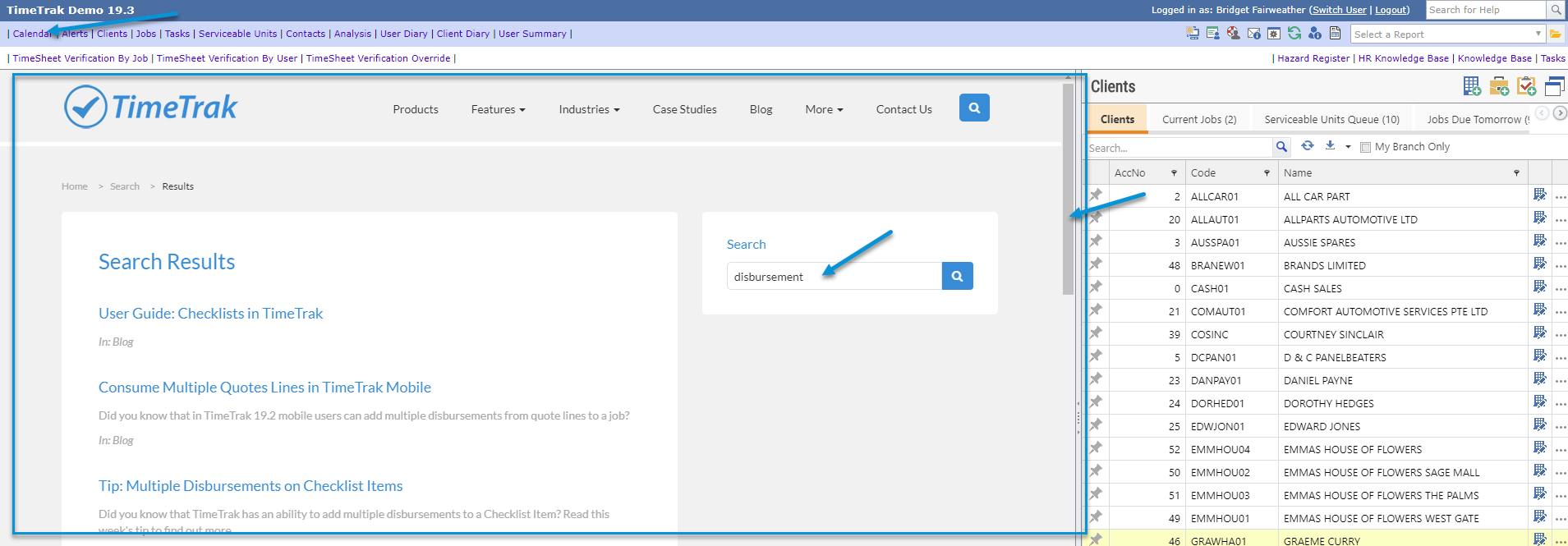
To return to the calendar view, simply click “calendar” in the top left hand corner
As part of this change, the icon to run reports has also been changed as per below:

18. Add new help box to checklist items to display the description of check checklist item
Continuing with the theme of end user self-help, in 19.3 to assist users when creating and managing checklists within TimeTrak there is now an end user description of each check list item as per below:
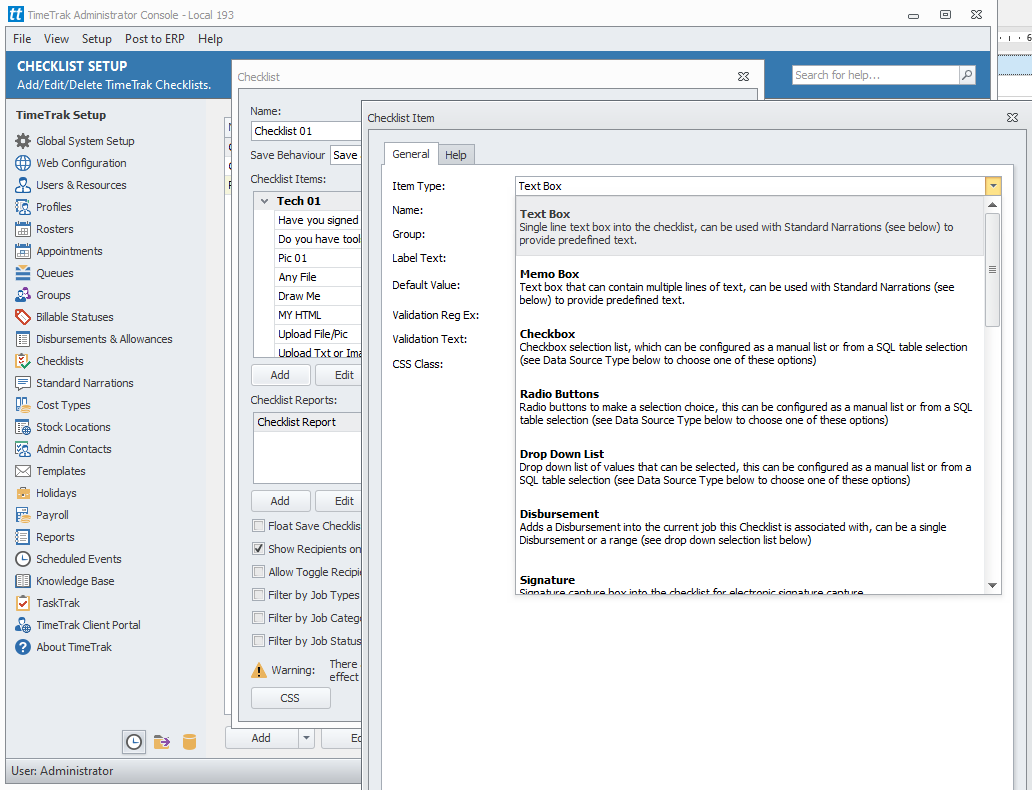
Whilst the ability to add and edit purchase orders for jobs was added to TimeTrak Professional in version 4.0 there was no ability to add custom fields to the purchase order.
In 19.3, the ability to add custom fields to purchase orders has now been added providing further flexibility.

20. Ability to update purchase orders to “fully processed” in TimeTrak Professional
Again, whilst the ability to see fully processed purchase orders against a job in TimeTrak Professional has previously been available.
In 19.3, there is now the added ability to set a purchase order to “fully processed” in TimeTrak Professional.
To enable the ability to do this, the below additional profile setting will need enabled:
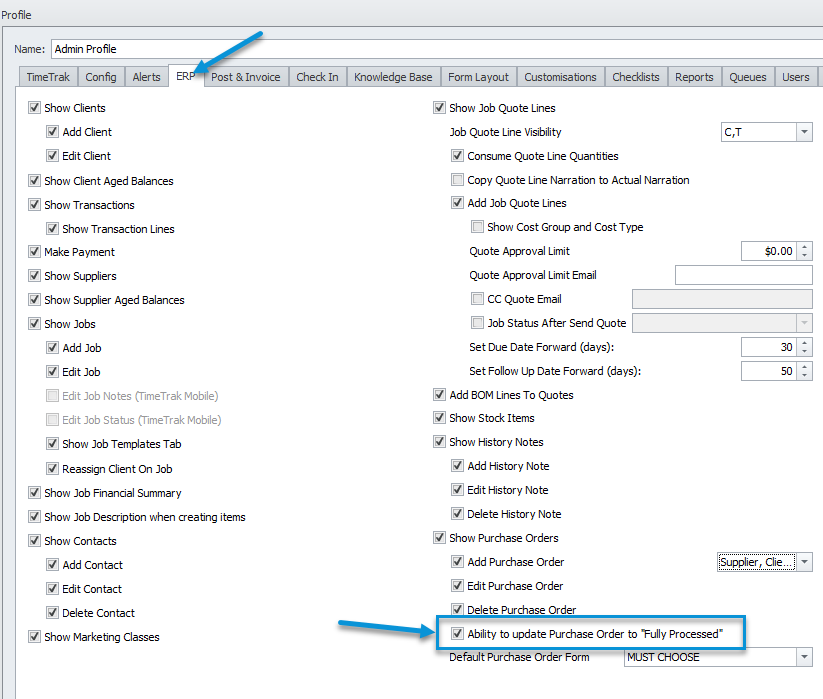
Once enabled, users assigned to the profile can right click on the purchase order and select “Set Status to Fully Processed” as per below:


21. Limit what purchase orders can be created against in TimeTrak Mobile.
In previous versions of TimeTrak, if a Mobile user has the ability to raise a purchase order it can be raised against a supplier, client, job, task (if TaskTrak is enabled) appointment or time entry as per below:

In 19.3, there has been an additional combo box added to the profile setting “Add Purchase Order” as per below.
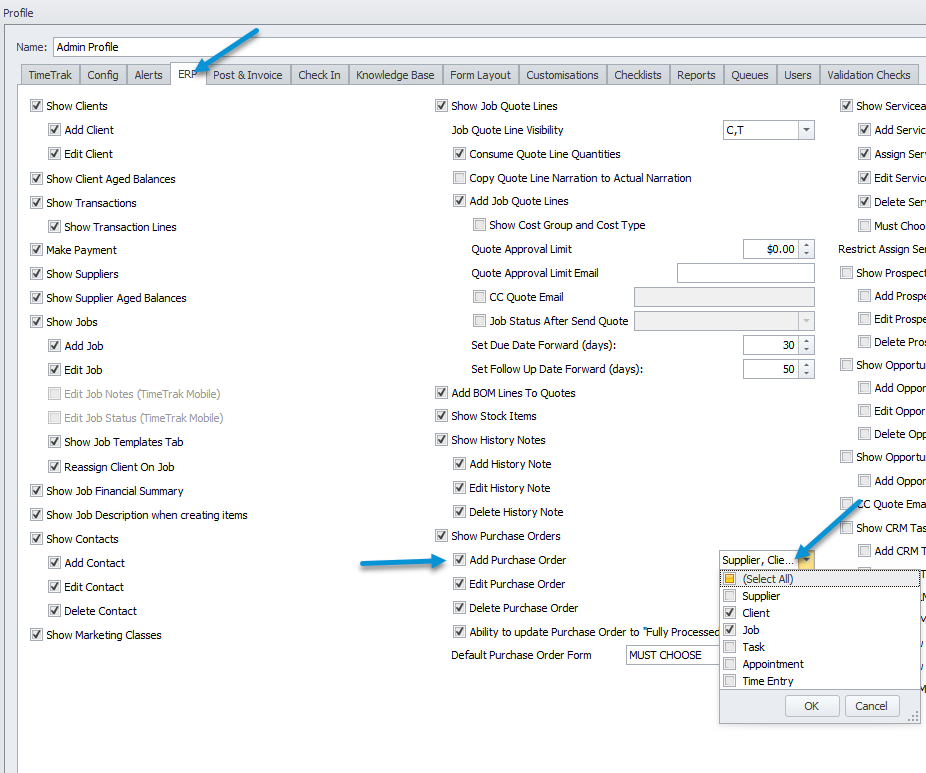
On upgrade, all options will be enabled if the profile has the ability to add purchase orders.
However, there is now the ability to control which items purchase orders can be created against in TimeTrak

22. Prevent start and end time being altered when a Mobile user is using the check in/ out function.
As part of many business processes, TimeTrak Mobile users check in and out of items as a way of recording their time throughout the day.
In previous versions of TimeTrak, there was no way to limit the ability for Mobile users to edit the start and end time of time entries if they had the ability to add time manually.
In 19.3, there is an additional profile setting “Prevent check in time being altered” as per below:
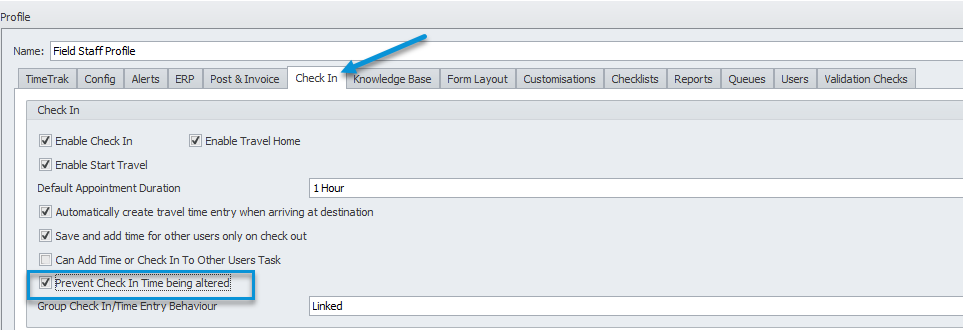
Once enabled, if the user has checked into the item they are unable to edit the time entry start time, end time or duration as per below:
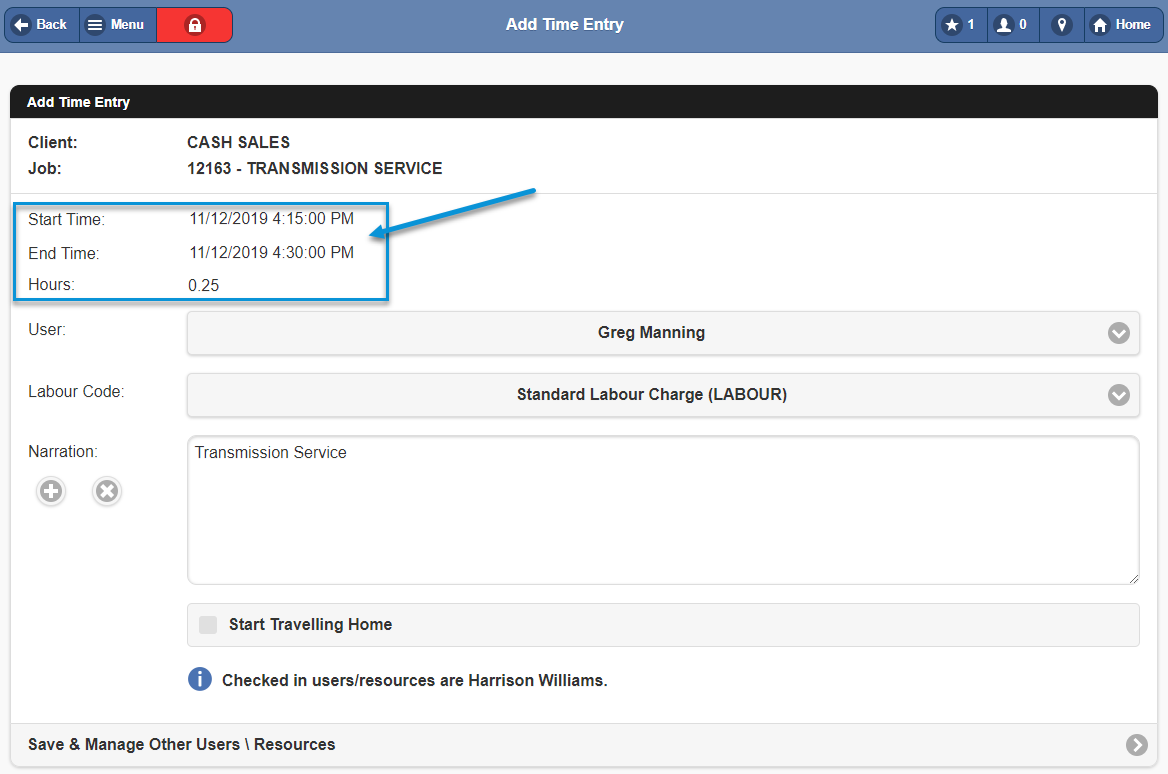
This information is also unable to be altered for users working in team environments when using the check in function as per below:
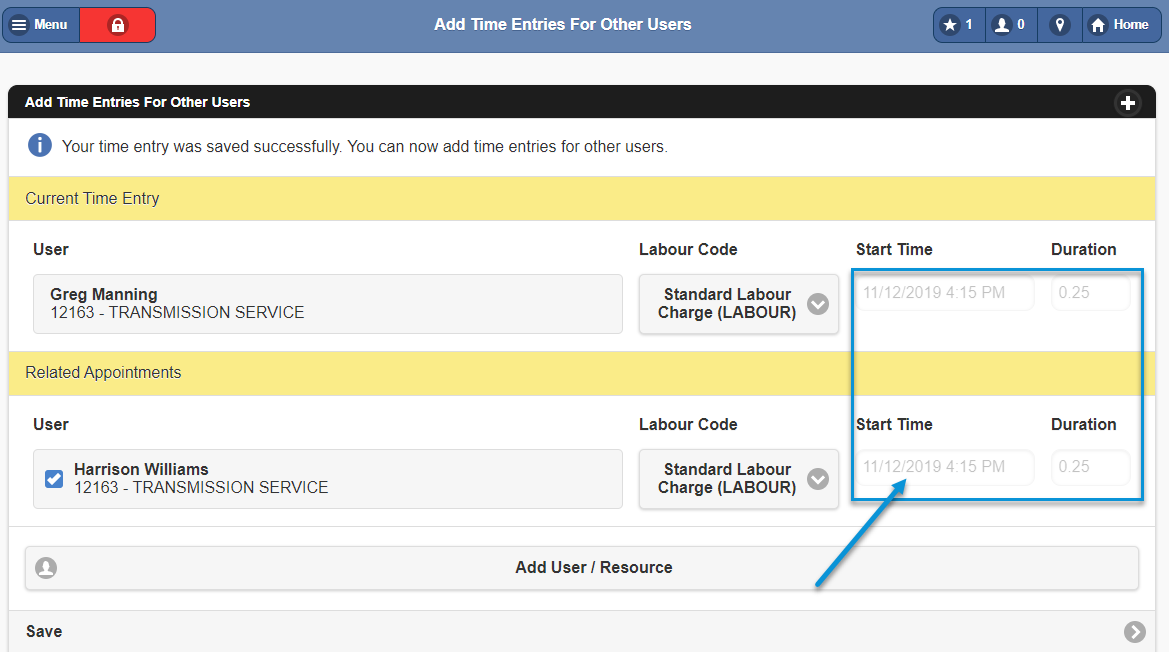
However, if the time entry has been created manually against a job, task or time analysis code these fields can still be set as per below:
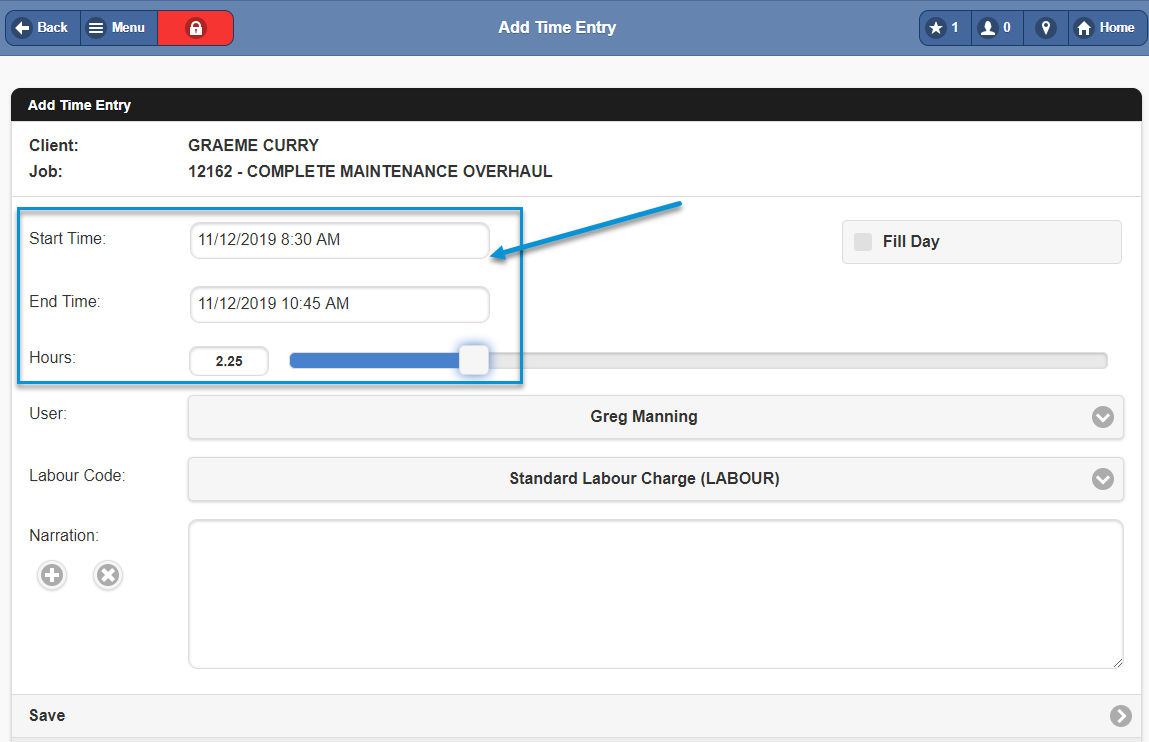
23. Extend Mobile date range options
In TimeTrak version 19.1, the setting “Mobile Calendar Range” was introduced to allow Mobile users to see up to 7 days of their calendar from the Mobile home screen as per below:
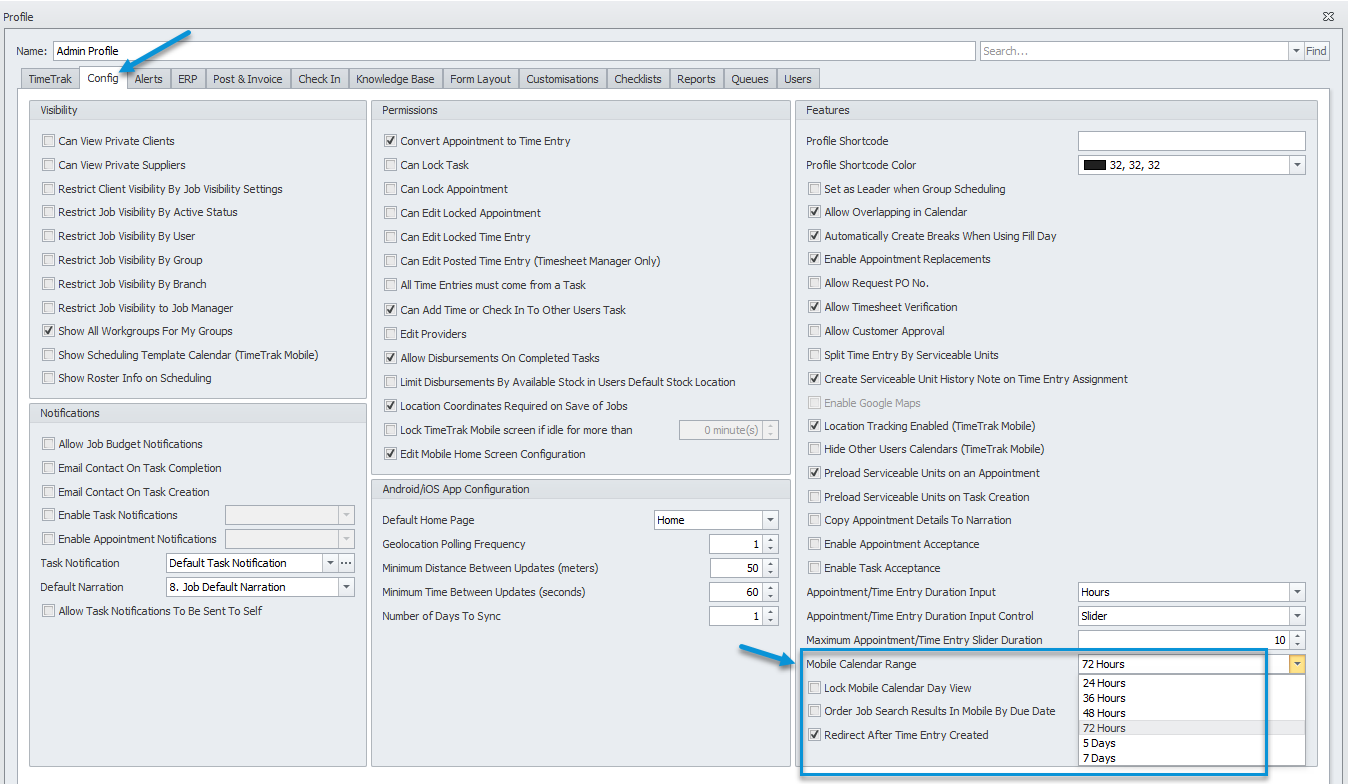
In 19.3, this has been extended providing both 14 Days and 31 Days options as per below:
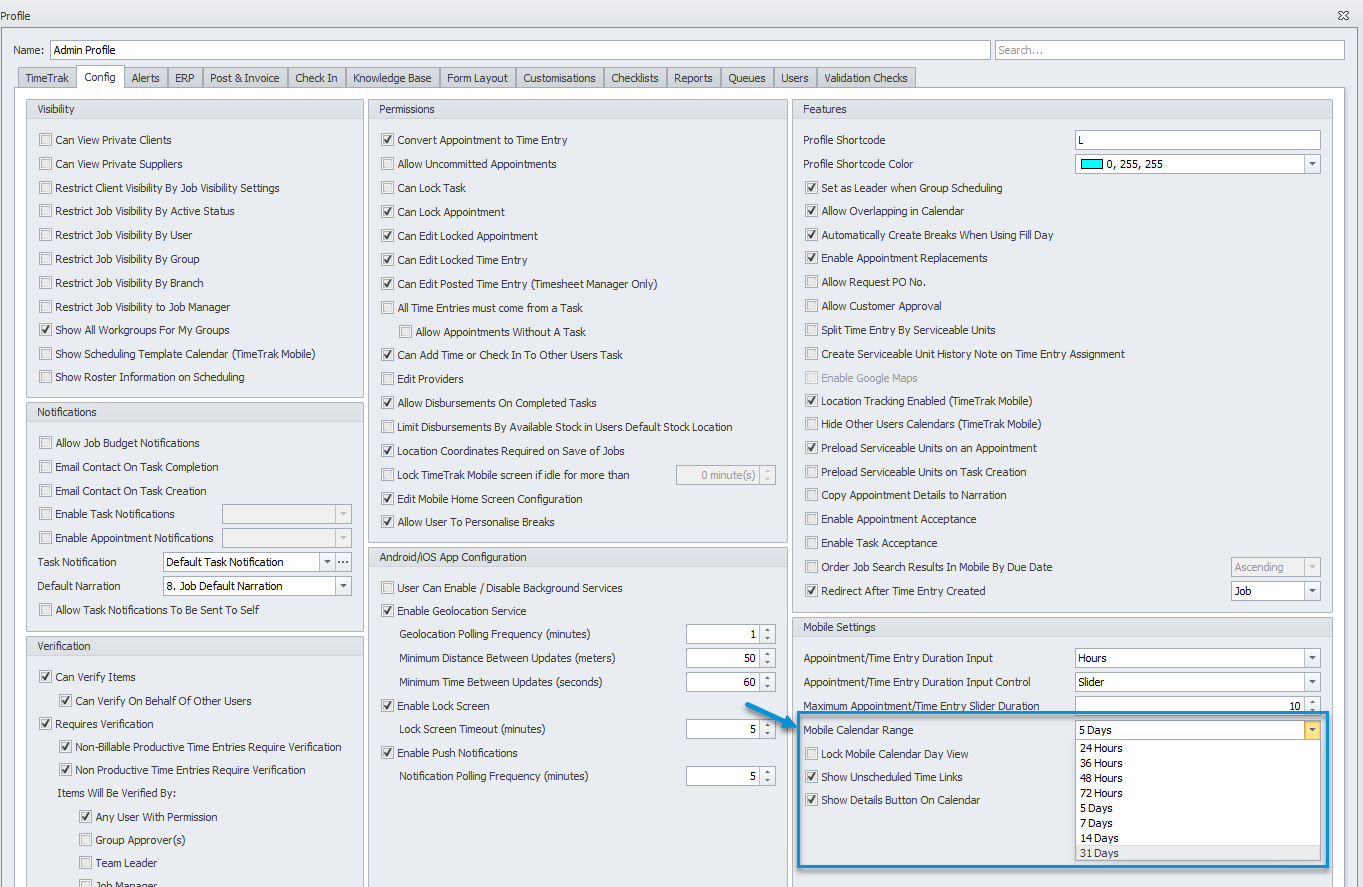
When set, users can see this calendar range from their home screen in Mobile providing further visibility of upcoming scheduled work.
When in the full calendar view within Mobile, the calendar range set against the profile also becomes the default instead of “next day” which it was previously.
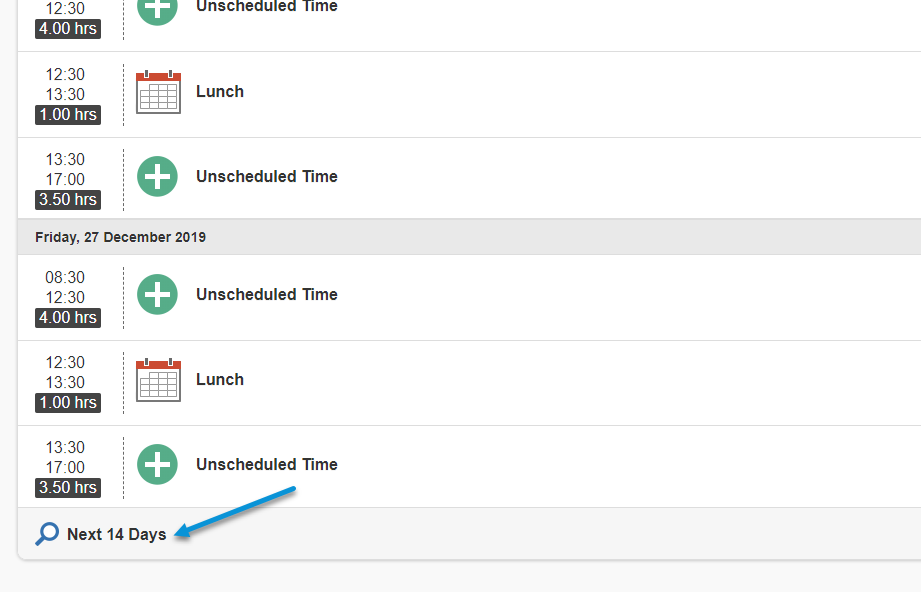
24. Show Unscheduled Time Links
To complement the previous setting, which allows users to see up to a month of their calendar in TimeTrak Mobile. In version 19.3, there is now also the added setting “Show Unscheduled Time Links” as per below:
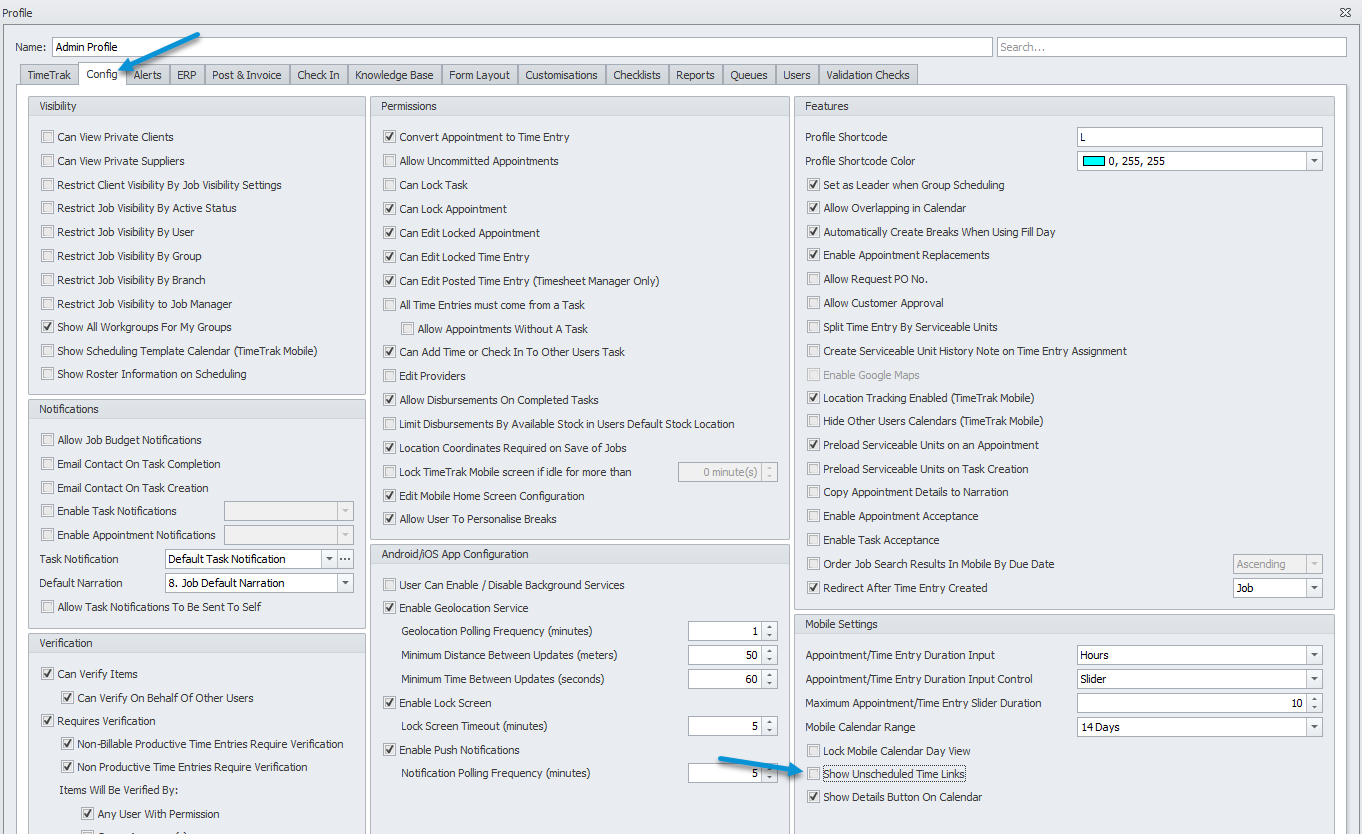
When enabled, previous standard behaviour will be displayed.
Any unscheduled time in the user’s calendar will display with unscheduled time links like below, which once selected will pass through the unscheduled time into the appointment or time entry.

If the profile setting is not enabled, then only appointments and time entries will display in the user’s Mobile calendar as per below:
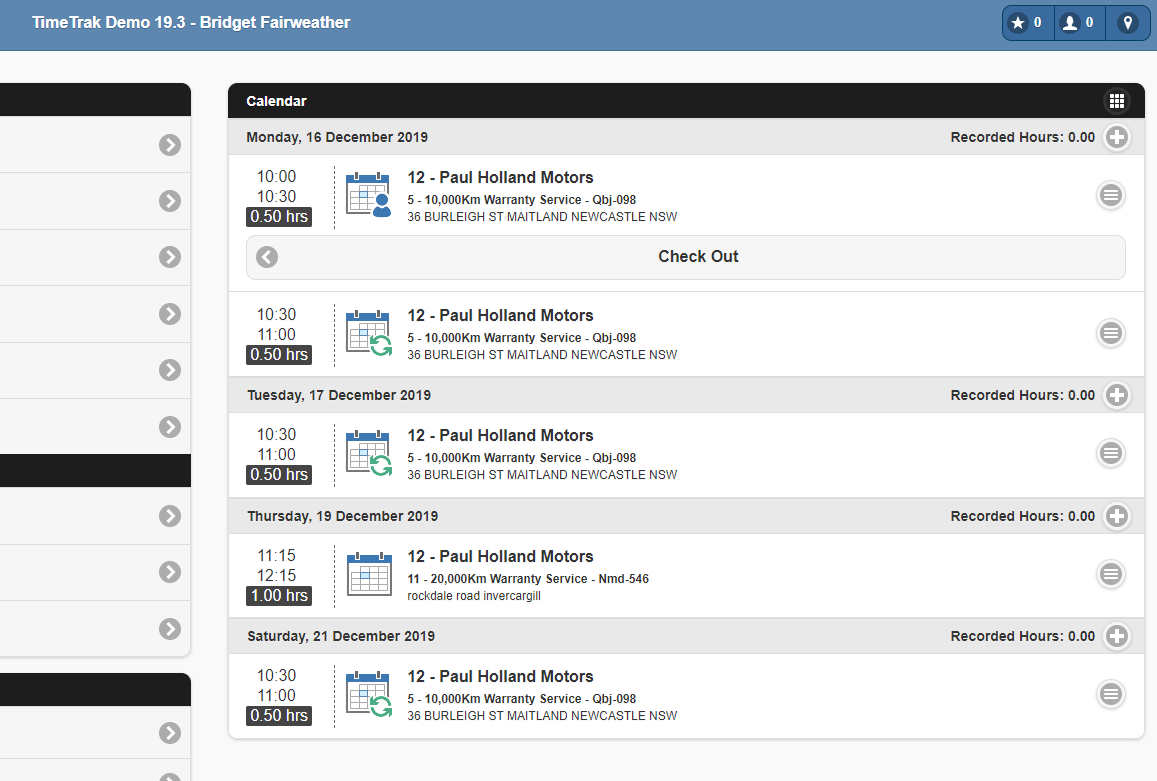
25. Task Management Improvements and Deferred Tasks
TimeTrak 19.3 introduces new features to assist with Task Management including updates to the alerts screen, ability to allocate tasks quickly and a new “Deferred” Task function.
Task Right Click updates including “Allocate to Me” and “Add Sub Task” have been added to the task grid as per below:
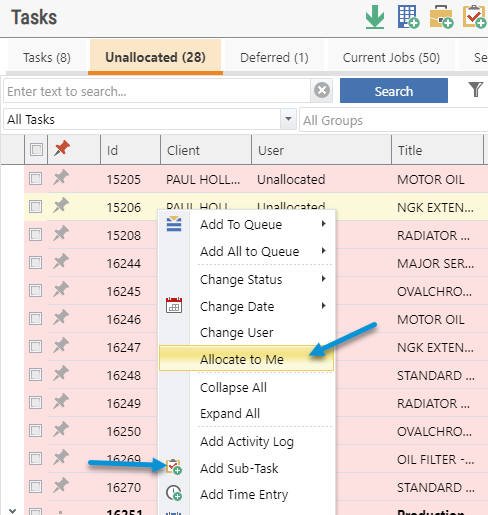
There is also now the ability to mark a task status as deferred, and at a profile level enable deferred task review as per below:
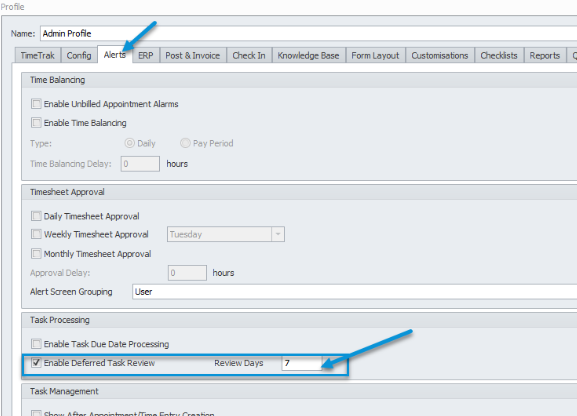
The purpose of marking a task as “deferred” means the task is effectively as on hold and not a part of the user’s current active work load providing management further overview of current resource allocation.
When tasks are marked as deferred the task moves to a separate “deferred” tab (similar to the unallocated task tab).
When the deferred date is met and the user’s profile has deferred task review enabled, they will be forced to update the task or defer the task again.

The Alerts screen within TimeTrak Professional has also been re-written in 19.3, users can now access knowledgebases from the alerts screen and update tasks via right click functionality.
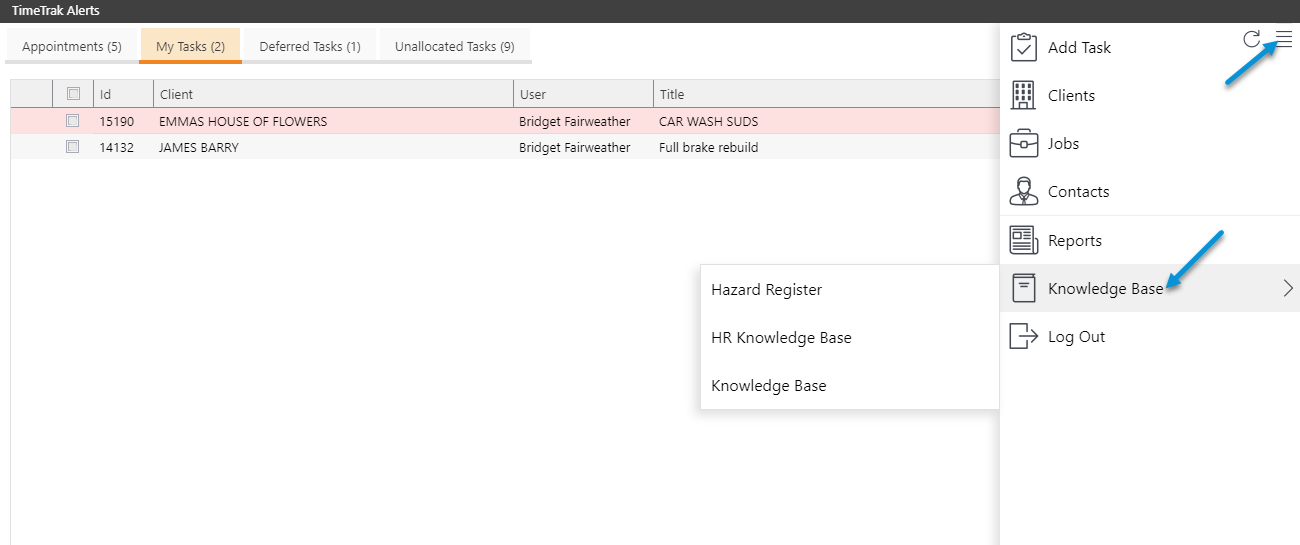
Continuing with the right click updates of tasks, this is also now possible via the time entry screen as per below:
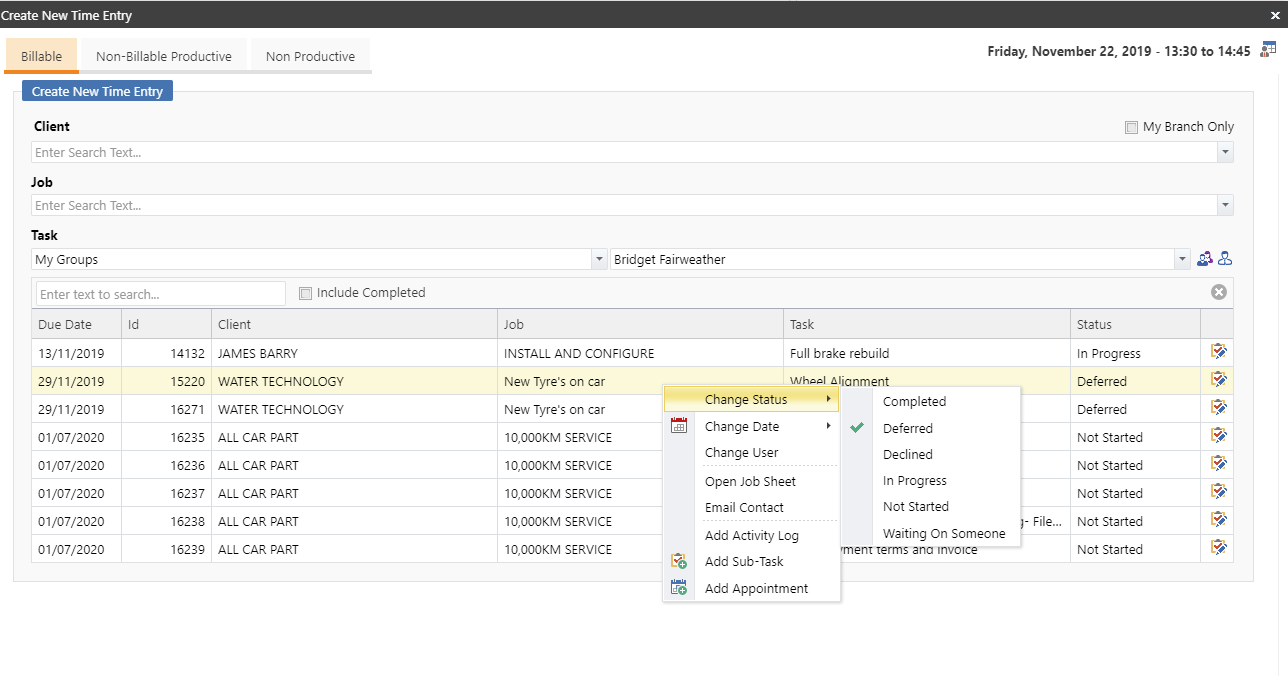
Multiple Tasks can also be updated at once in 19.3, by selecting the tasks and using the same right click update function.
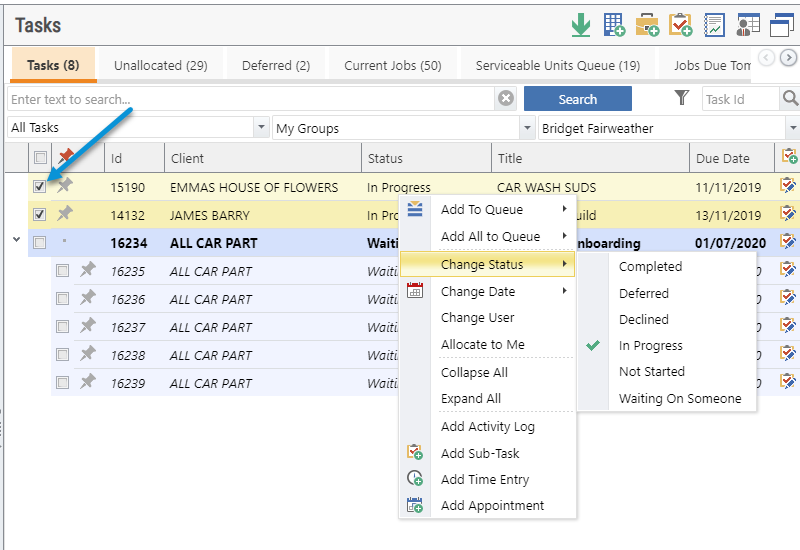
Task Colours have been re-introduced in version 19.3:
Red = Task Is overdue
Blue = Parent Task
Yellow = Selected Task
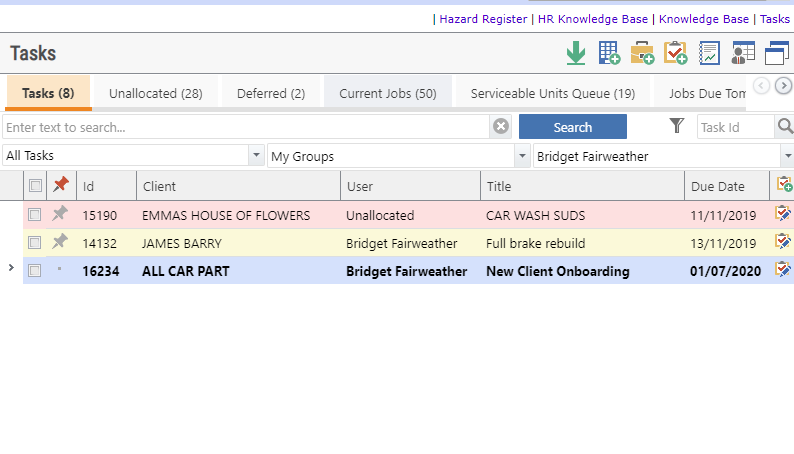
There is also an added Tasks tab against clients in TimeTrak 19.3, to provide the ability for users to review tasks at the client level instead of needing to go in and out of jobs to review these:

For more information on the tasks improvements and deferred tasks in 19.3, click here.
26. Closing a Job that has open Tasks and Future Appointments
Continuing with Task Management improvements, in previous versions of TimeTrak a job could be updated to inactive status such as “completed” or “cancelled” when it still had active appointments or tasks assigned to it.
In version 19.3, when a job that has active appointments or tasks assigned to it is updated to an inactive status in Professional, on save the below prompt will appear.
On clicking “Save” the appointments will be marked, as deleted and any open tasks will also be marked as completed.
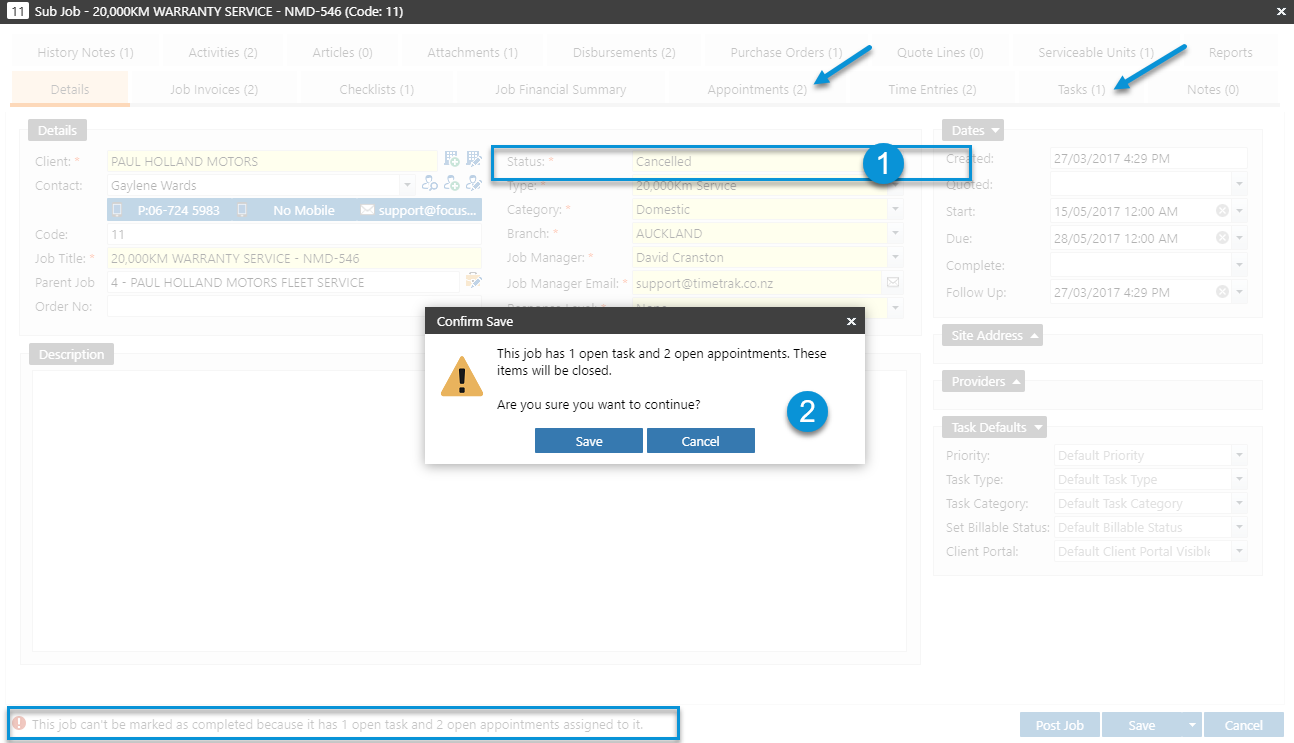
To review the tasks and/or appointments prior to them be closed click “Cancel” on the above screen where users can review and manually close active tasks and appointments against the job.
27. Export Report Schedule
Adding to TimeTrak’ s Scheduled Event options in version 19.3, there is the added ability to setup an “Export Report” scheduled event.
Similar to the “Email Report” schedule, the Export report function generates a report on a scheduled basis to a set file location and has the ability to name the file based on data fields. For more information on Email Report Scheduled events click here.
This is a great addition for clients who would like to generate reports on a scheduled basis but do not necessarily want these to be emailed instead they can instead be saved to a shared drive to be reviewed when required.
This could also be a useful feature for clients who need data from TimeTrak in a set file/ data structure to be picked up by a sync tool to another software application.
To set this up, within the TimeTrak Administrator Console:
Scheduled Events > Add > Export Report Schedule as per below:
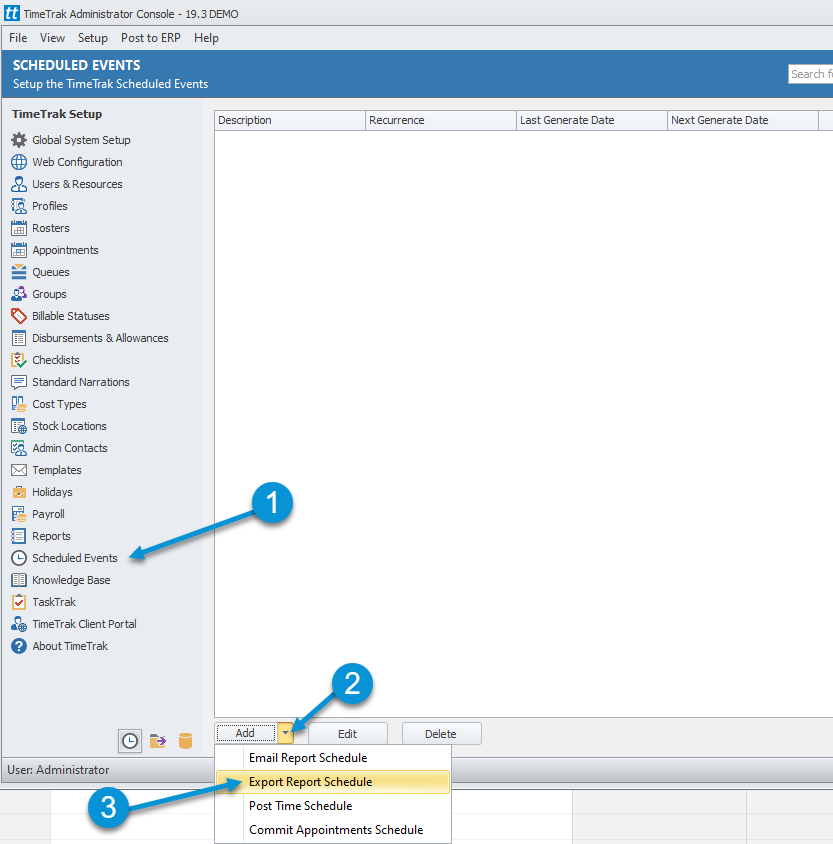
The below form will pop,
- Give the schedule a name
- Select the report you wish to generate
- Enter the folder location and credentials used to access the folder location
- Check folder credentials
- Enter the data source for file name data (either a custom SQL query or a direct table)
- Validate the data source query
- Using the … button select, the data fields from the data source query to pass into the file name.
- Click Preview to review file names based on the data source
- Enter the report parameters
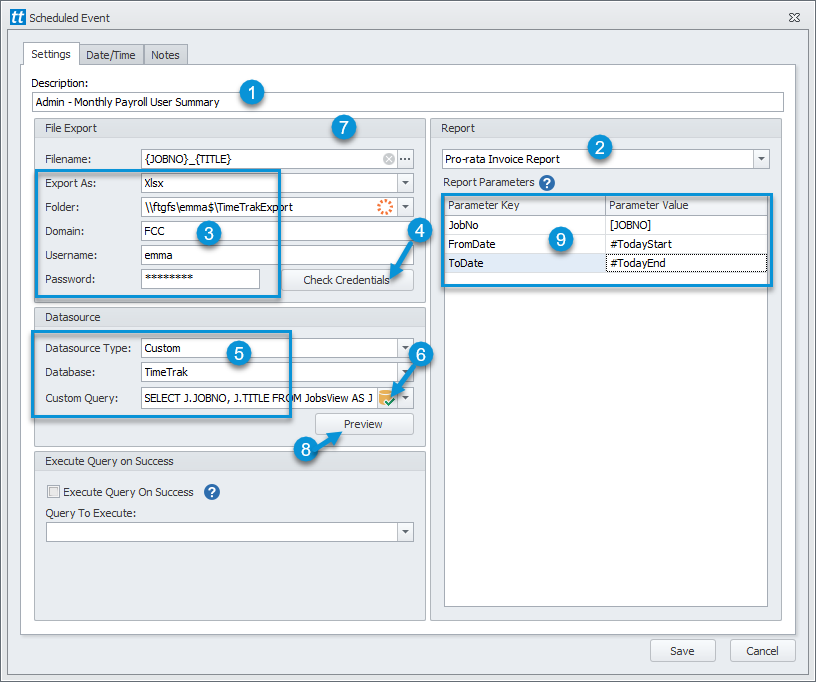
Schedule the report export’s frequency:
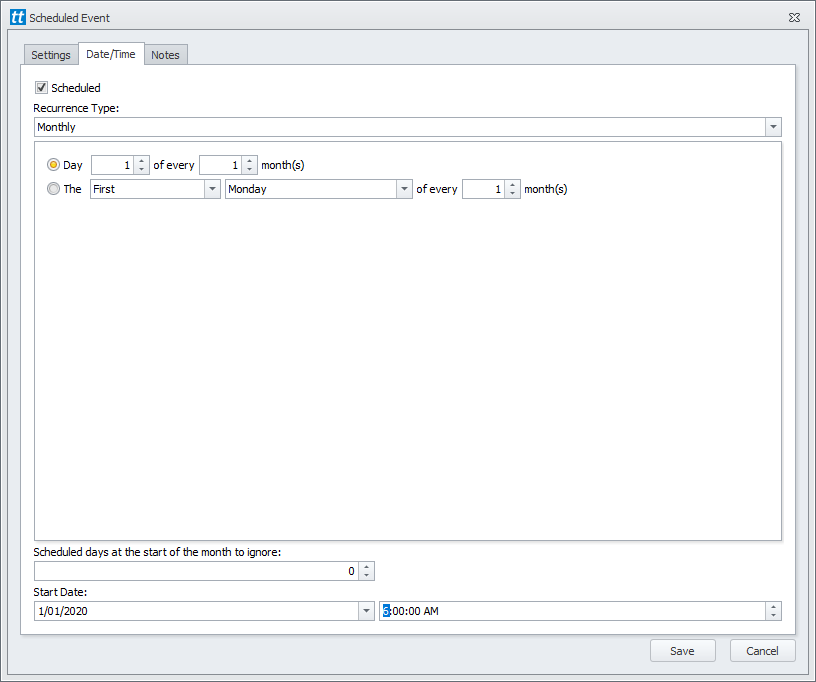
Notes (for reference) can be added to the notes tab.
Save
The Scheduled Event will display under the Report Export heading via Scheduled Events in the TimeTrak Administrator Console as per below. The Scheduled Event can be manually run by right clicking and selecting “Execute Schedule”
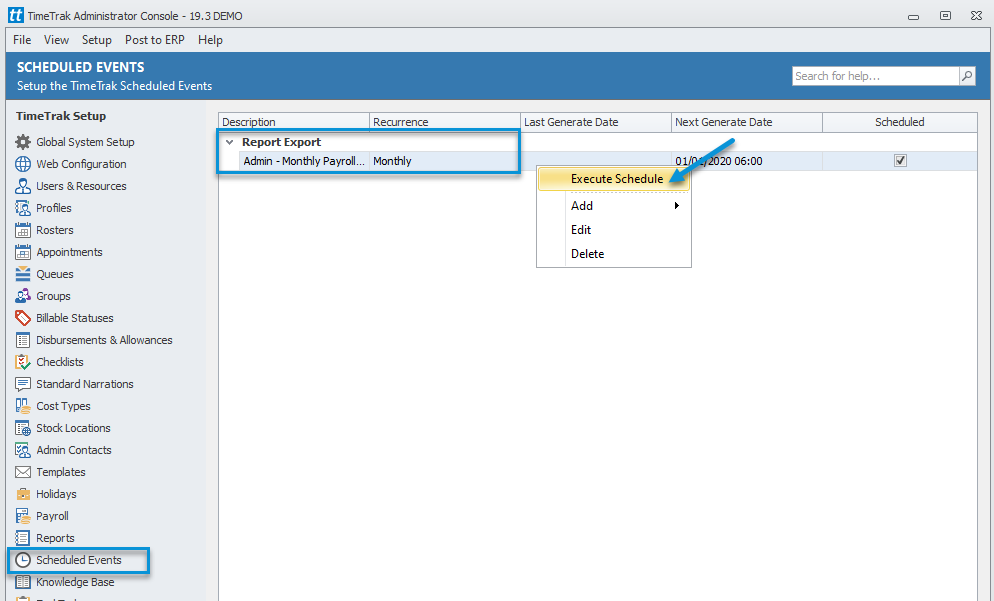
Once the schedule has been generated successfully the below confirmation will appear:
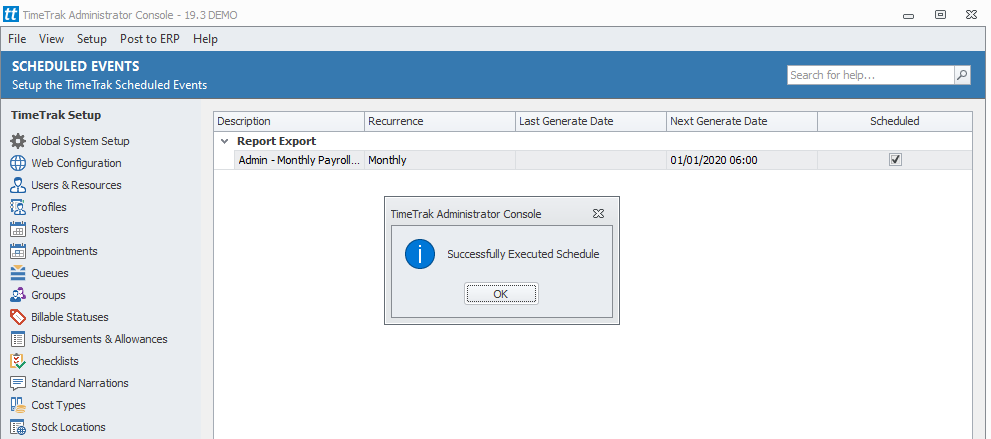
Within the specified folder location, created files will be located with the specified data file name:
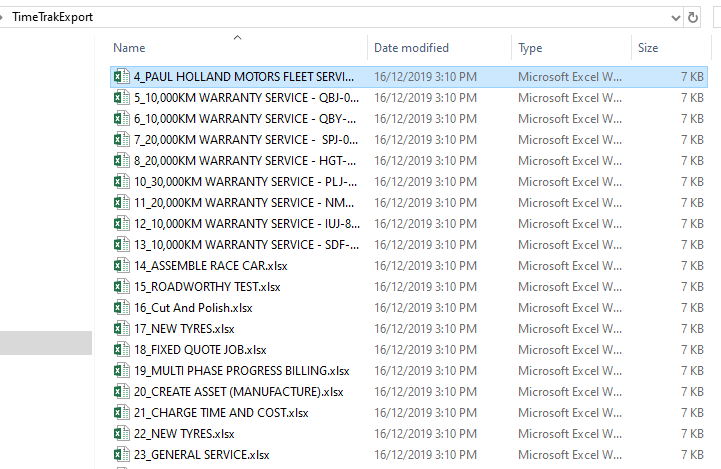
28. Validation Checks on Time Entries and Appointments
To provide further flexibility within TimeTrak in version 19.3, against user profiles there is the ability to enable both Appointment and Time Entry Validation checks.
This is a useful feature for businesses who are require time entry and or appointment creation to be prevented based on set criteria.
A working example of this may be a servicing client who has to abide by their client’s quarantine rules to prevent cross contamination. In the database extra fields would be set up to manage which clients/ jobs these quarantine rules apply to then against the user profile(s) both appointment and time entry validation checks can be enabled
In this example, a stored procedure is applied against the database to run and check all the criteria and the query applied to the profile is looking at this stored procedure;
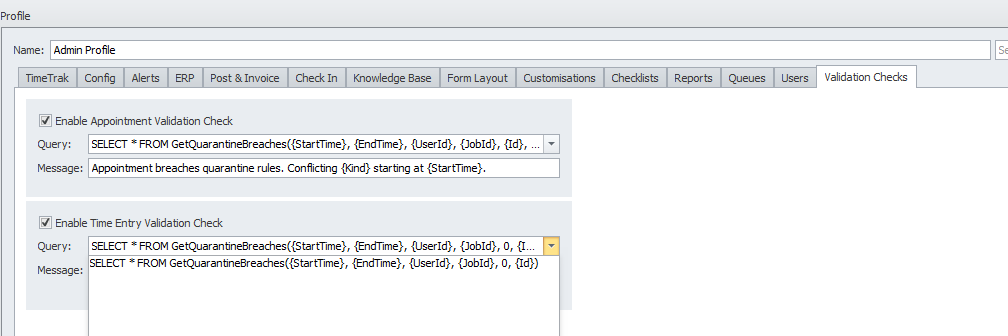
When scheduling is completed for a user assigned to this profile and the validation criteria is meet the below error message is displayed (message assigned to the profile) and the user is prevented from scheduling the appointment:
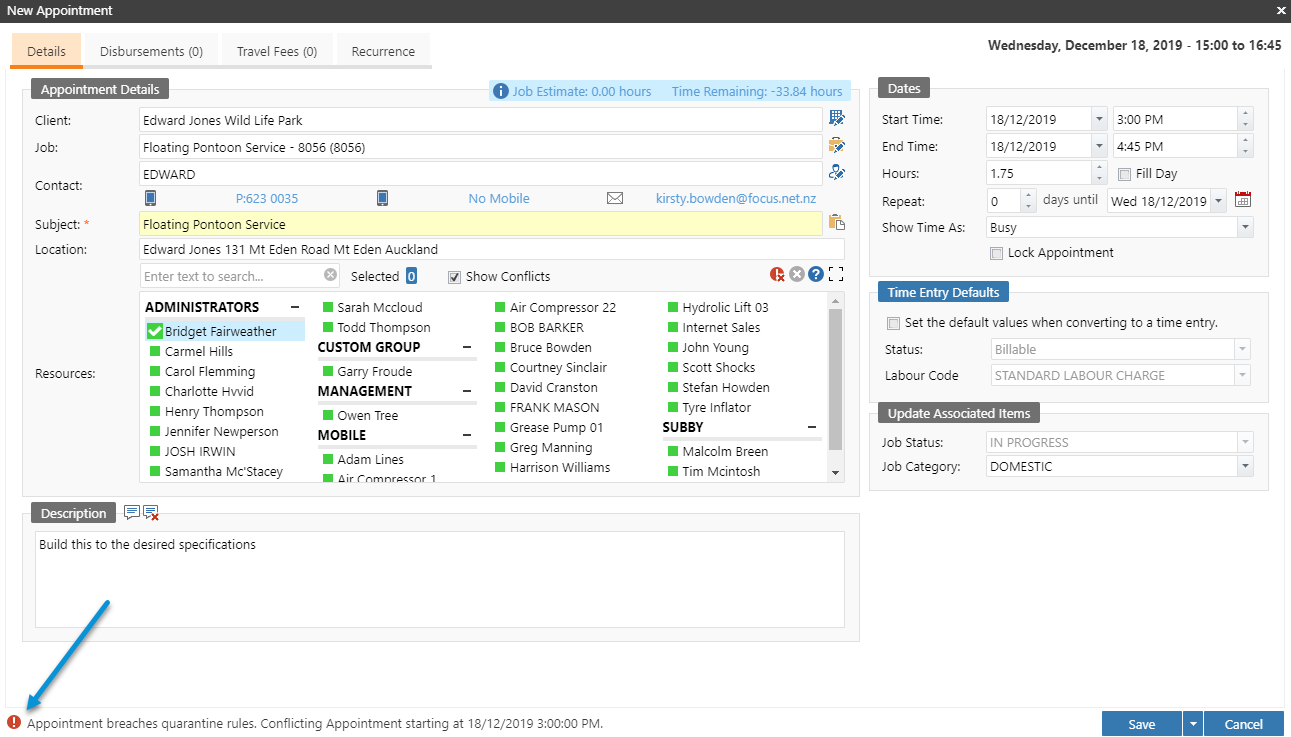
The same behaviour applies for time entries; these are prevented from being created until the conflicting appointment or time entry is adjusted.
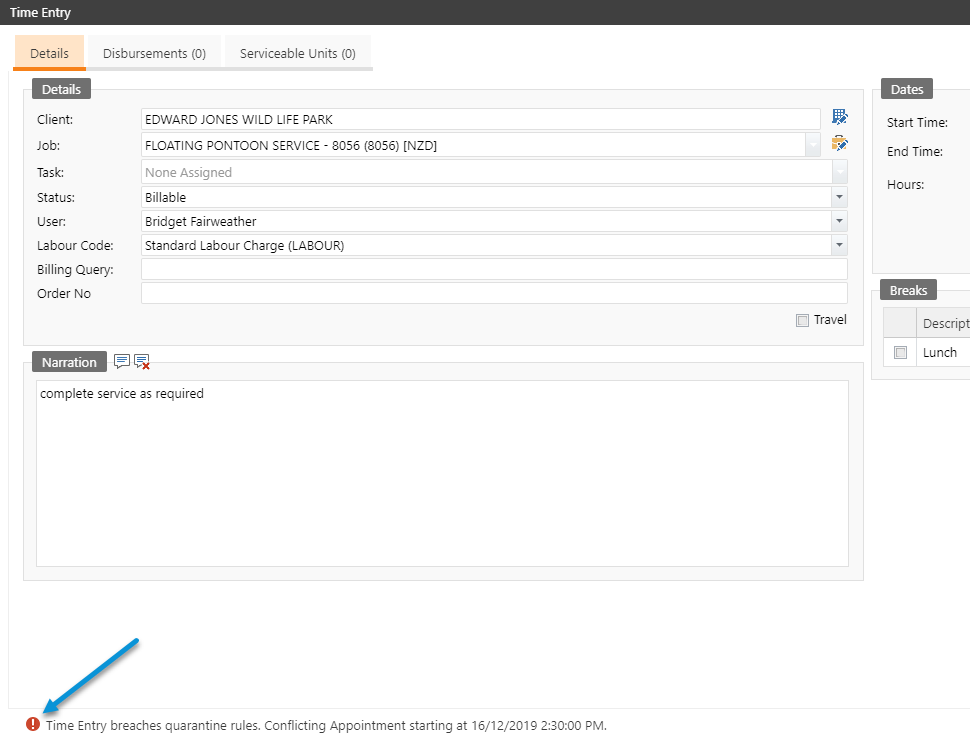
29. Checklist Enhancements
Checklist enhancements have been continued within TimeTrak in version 19.3 with the below additional features.
29.1 Checklist tab to Jobs
In some environments when many attachments and checklists are generated against jobs, data can be better managed if checklists are separated from attachments.
In 19.3 via TimeTrak Professional, against the job there is a new Checklists tab which displays checklists that have been completed against the job and can be re-run via the checklist report icon as per below:

When the checklist is run via the report icon above it will run the checklists results in the current report format meaning if you have made changes to your checklist report historic checklists can be re-run in the new format.
The original checklist and report format it was completed in is still available via the attachments tab as per below:

29.2 Ability to not save Checklist Result PDF to Attachments
With the flexibility to re-run the checklist results in a report format as per above, in 19.3 there is the added ability to define whether the checklist results are saved as a PDF attachment or not as per below.
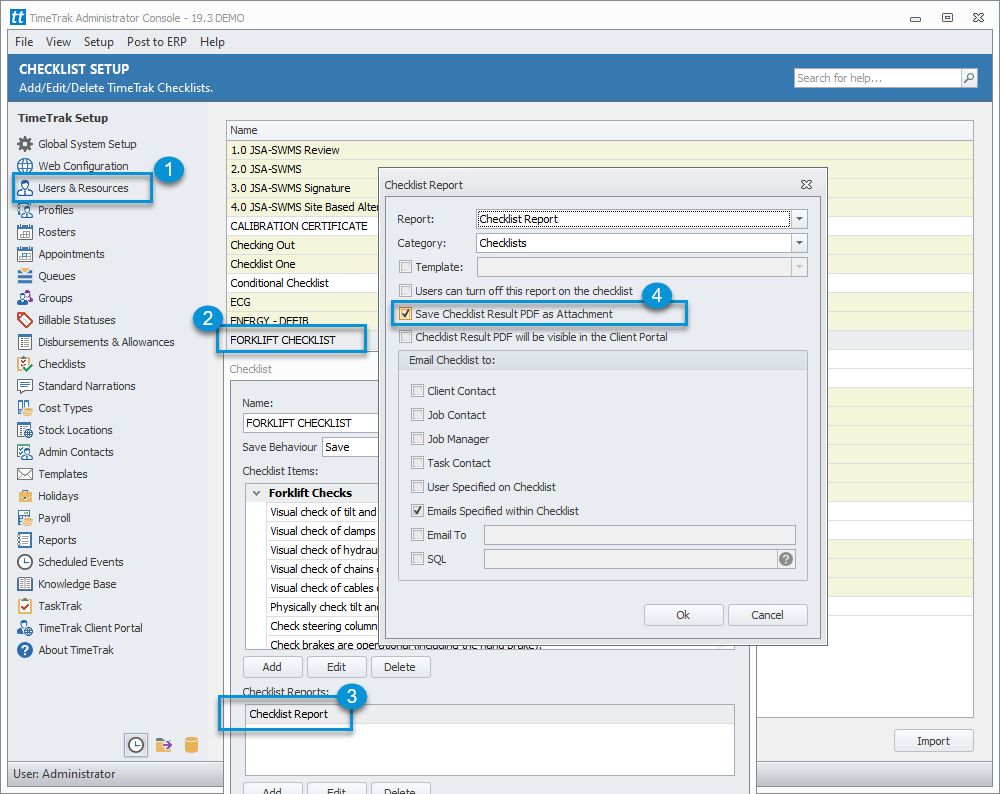
By default, this will be enabled to continue with the standard behaviour where the results are saved as a PDF. However, in some environments the data may not need to be saved in the original format if the report can be re-generated if and when required.
29.3 Checklist Status
Checklist Status is an additional checklist item added in version 19.3. Checklist status uses radio buttons in order for the field staff to set the status of the checklist which is then visible in TimeTrak Professional and can be updated by field staff once an action is completed.
A working example of this checklist item is if a field user was completing variation work.
For example, onsite to repair a unit and whilst onsite had to complete another piece of work that requires customer sign off.
The field user could complete a checklist for the variation work and mark the checklist as “unapproved”.
To set this up, with in the checklist select the checklist item “checklist status” as per below:
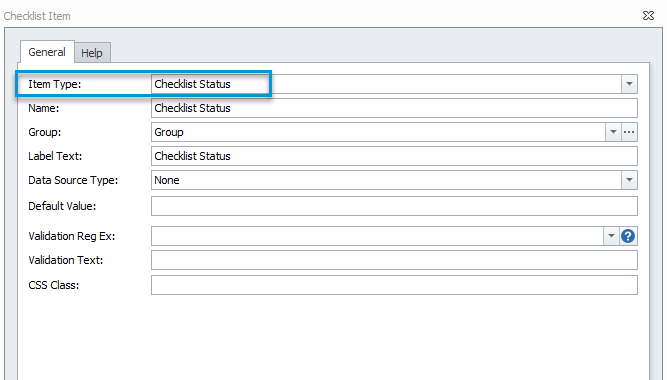
The default checklist statuses are Approved and Not Approved as per below:
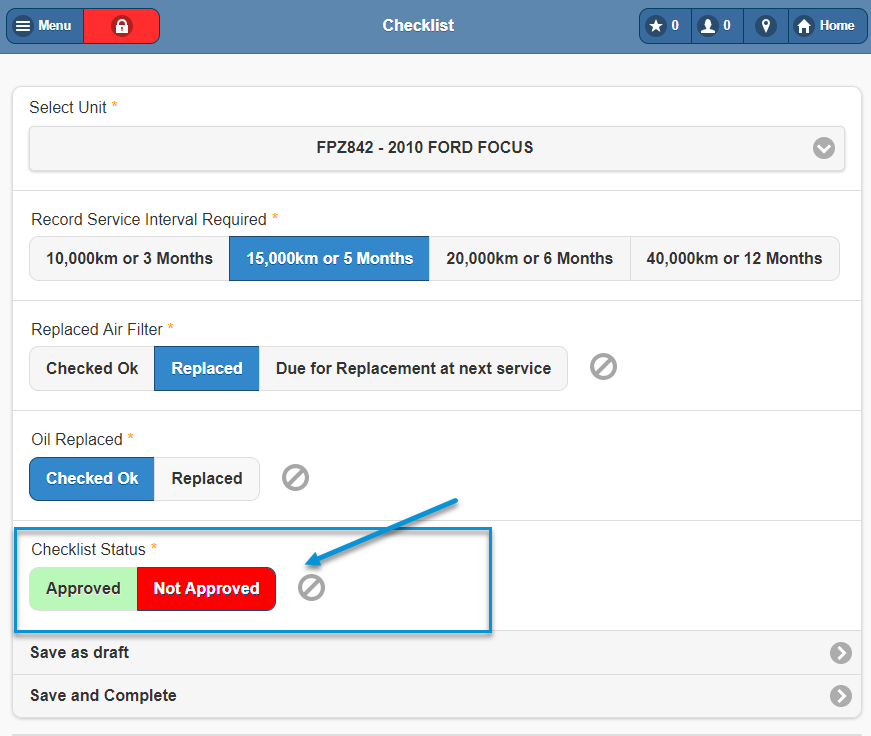
Please note: If the checklist status is “Not Approved” then users are unable to “Save and Complete” the checklist. A checklist status of Not Approved can only be saved as a draft as per below:
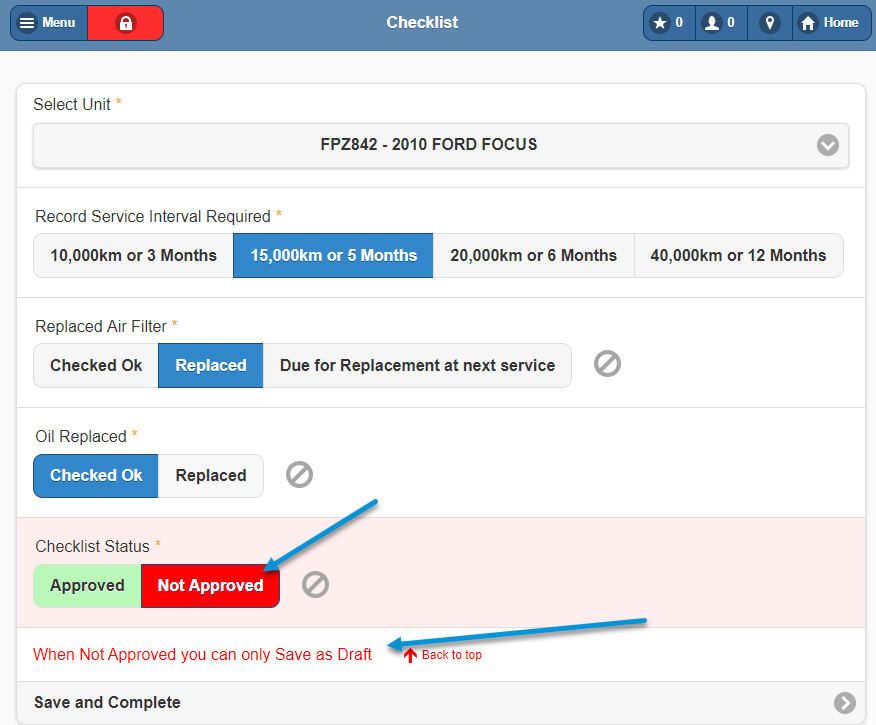
To enable to the ability for a checklist to be saved as a draft ensure that the save behaviour against the checklist is “Save as Draft + Save” as per below:
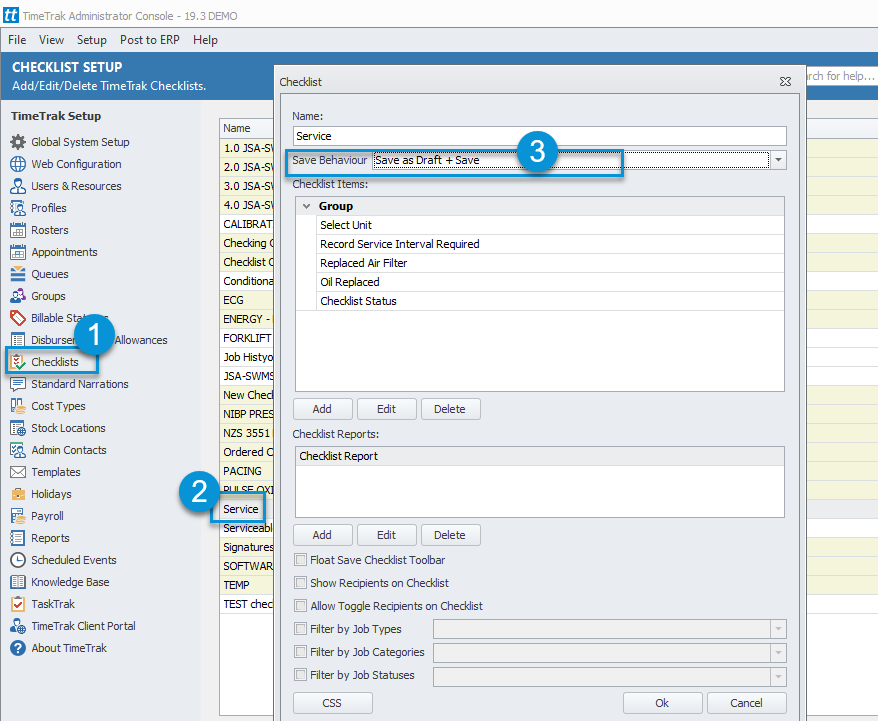
Which will allow the field staff to mark the checklist as “Not Approved” and save the checklist as a draft as per below:
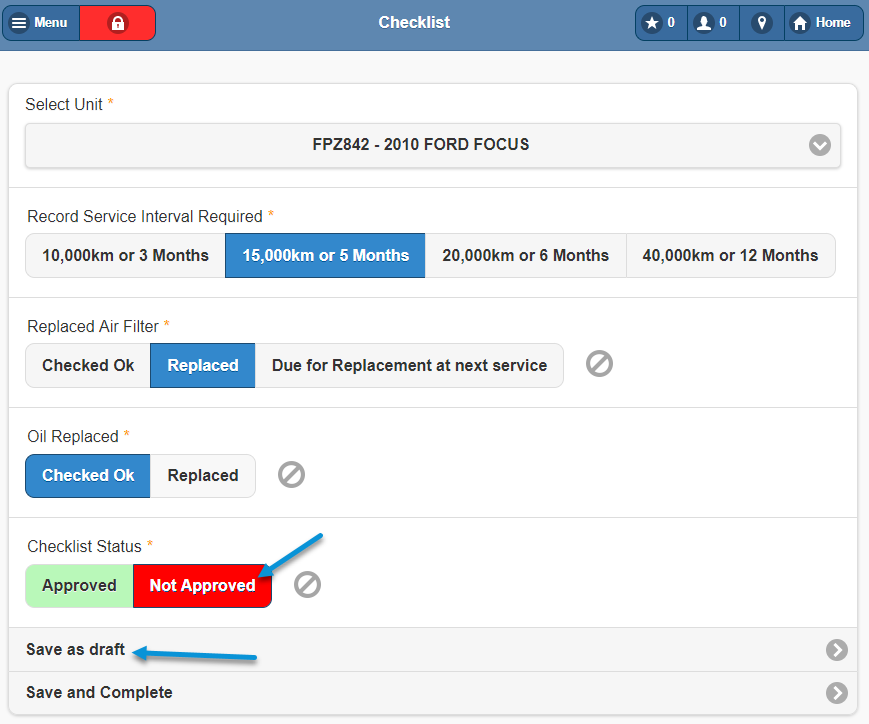
In Professional against the job, office staff can see the draft checklist and run the checklist report to review data as well as update the checklist status via run click functionality:

If the checklist has more than one report assigned to it as per below:
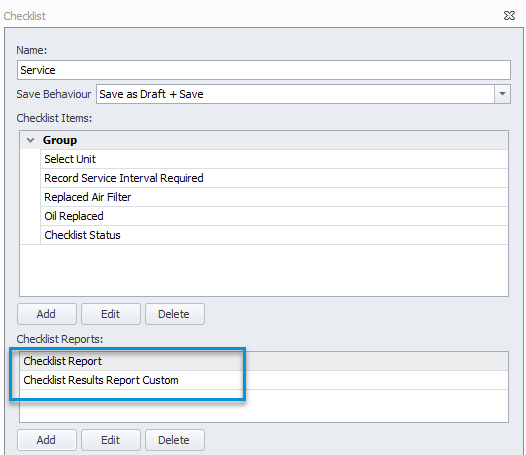
There will be a selection of which checklist report should be run as per below:

If the checklist statuses “Not Approved” and “Approved” are not applicable to your business processes, these can be customised by selecting List or SQL in the Data Source Type against the checklist item “Checklist Status”.
The default values are which prevent the ability to save and complete are as per below:
Approved = 1
Not Approved = 0
Therefore these could be renamed to something like below where “Requires Client Sign off” prevents the checklist being submitted and can only be saved as a draft.
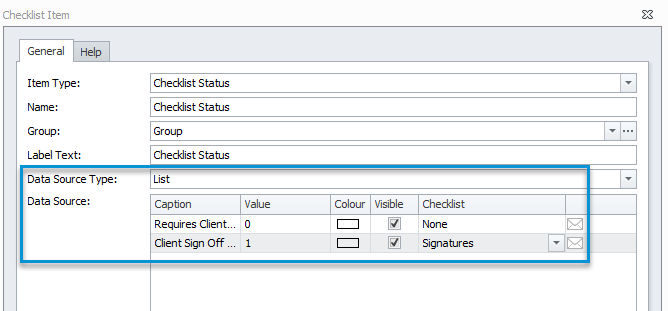
However, the checklist status “Client Sign Off Complete” allows the checklist to be saved and completed, and captures the client signature via a partial checklist.
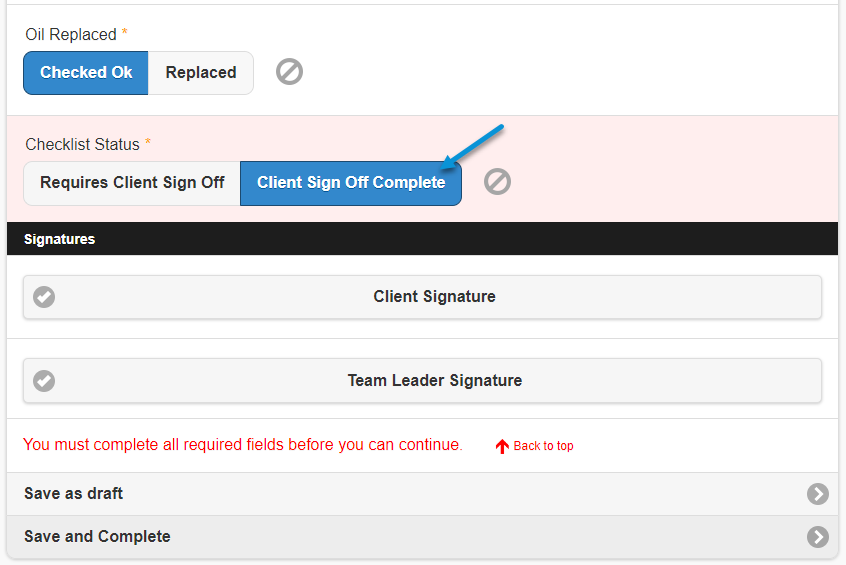
If validation text is added to a checklist item as per below:
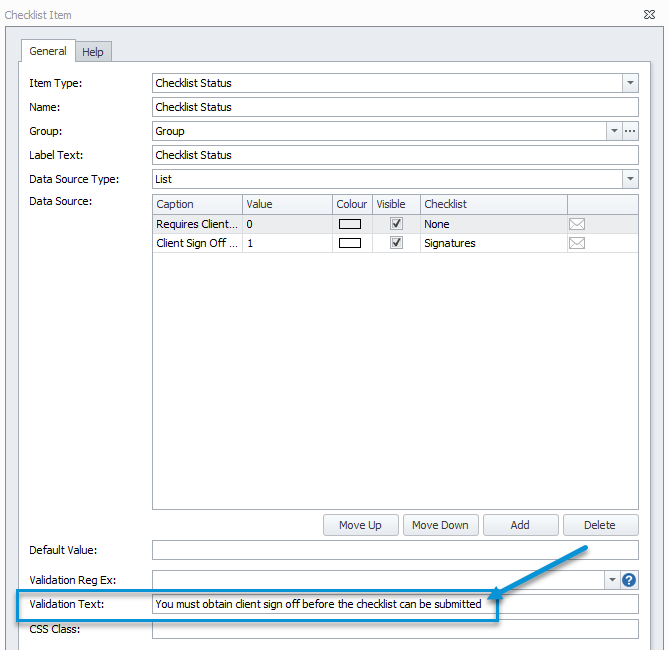
This can be displayed if the user does not select the correct item attempts to save the checklist list to provide them direction on how to submit the item as per below:
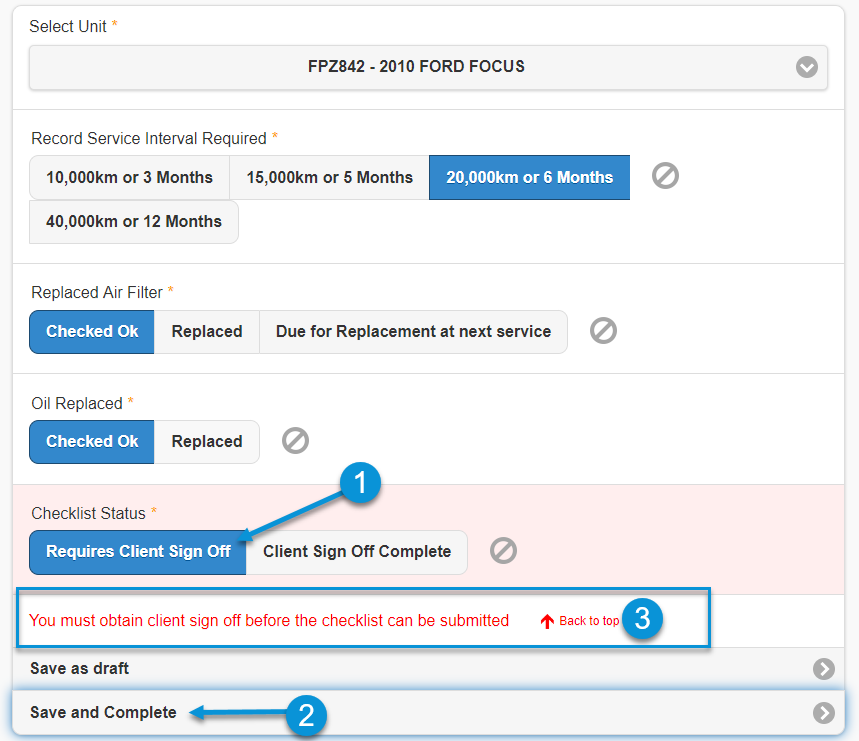
29.4 My Draft Checklists Menu Item in Mobile
The ability to save checklists as drafts within TimeTrak Mobile was introduced in version 4.0, click here for more information on draft checklists.
Continuing with the draft checklist functionality, in TimeTrak version 19.3 Mobile users have an additional item on their home screen “My Draft Checklists” as per below:
This item displays a count of the number of draft checklists the logged in user has across jobs to complete.
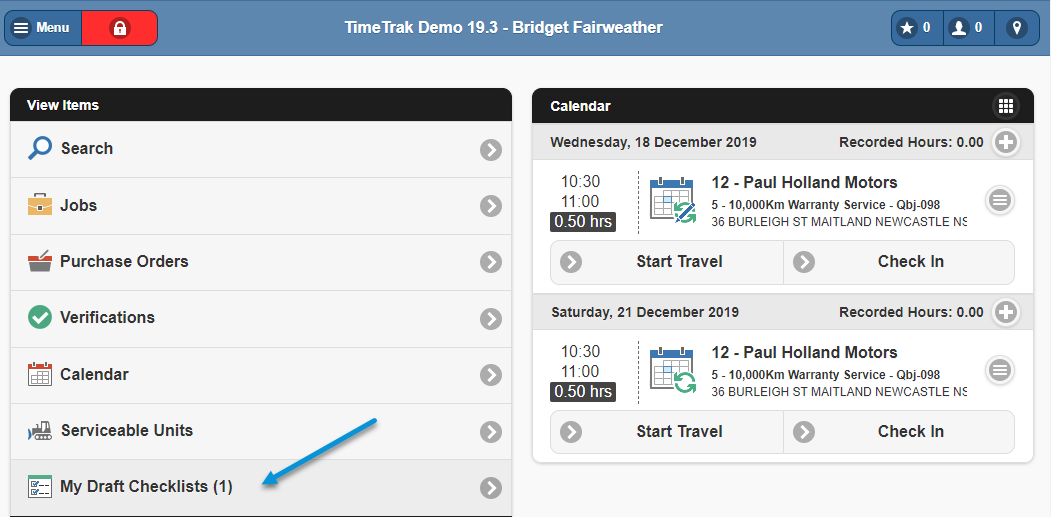
Clicking my draft checklists will take the user to the below screen where they can see all outstanding checklist items across jobs where they can then complete.

29.5 Ability to customise checklist styles in Mobile and hide checklist group Name
The final enhancement to checklists in TimeTrak 19.3 is the ability to customise checklist styles in Mobile as well as the ability to hide a checklist group’s name and or description.
Checklist groups are required to group checklist items, however often users do not want the group name to display within the checklist in Mobile or the checklist report.
To disable the checklist group name from displaying within the checklist in Mobile disable the below new setting “Text visible on checklist”.
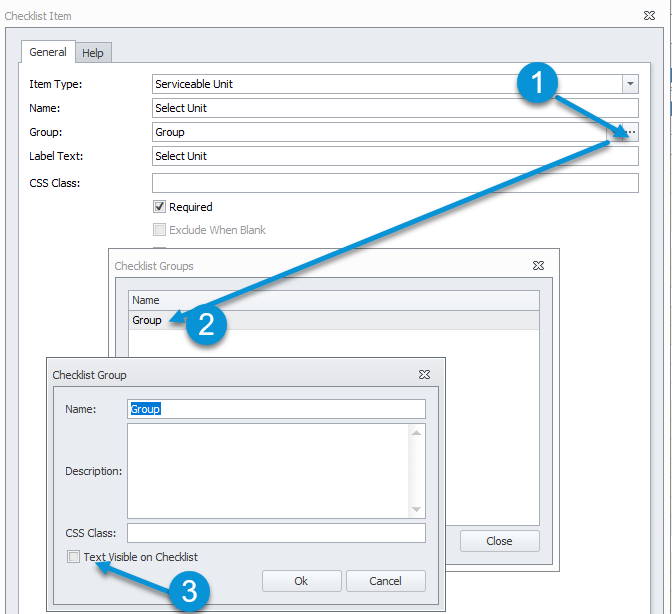
There is also the ability to add a CSS Class to each checklist, checklist group as well as each individual checklist item.
CSS stands for cascading style sheet and a basic knowledge of this is required to use this feature.
Populating these fields against a checklist provides the ability to display the checklist items in a different colour for example to make the item stand out to the mobile user whilst he is completing the checklist.
The CSS Class will have no impact on the checklist report it will only impact the way the checklist is displayed to the mobile user whilst they are completing it.
Against the checklist the CSS can be entered as per below:
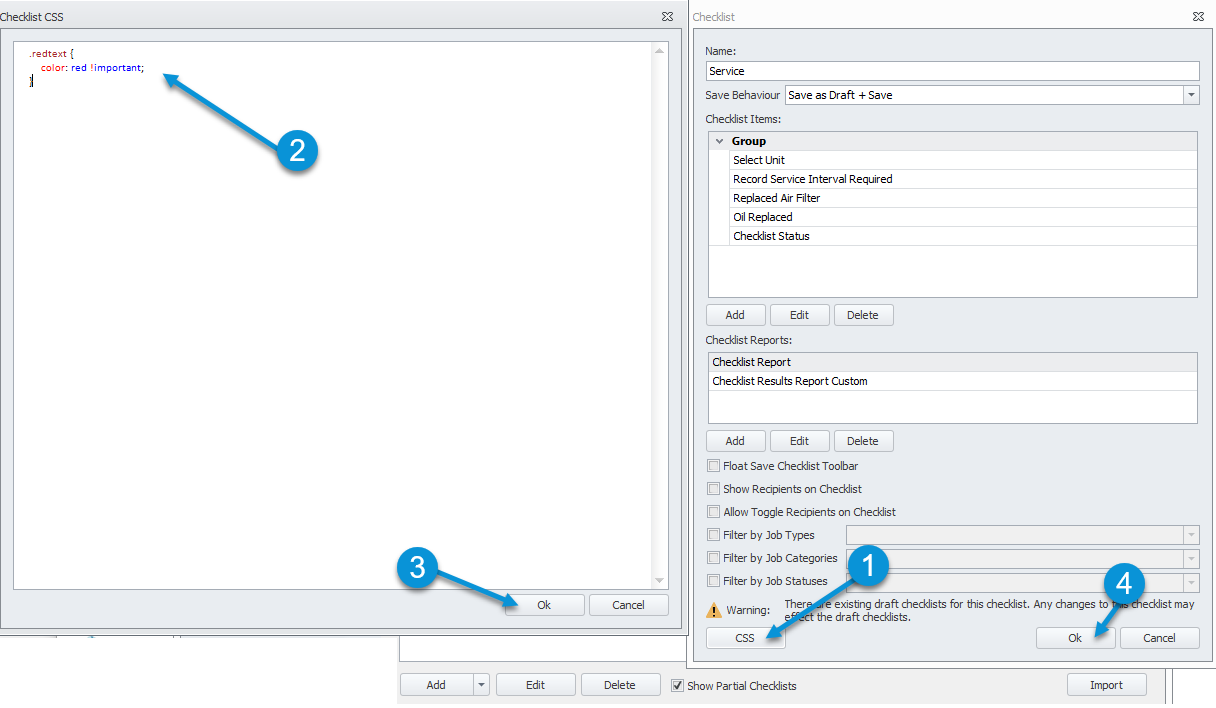
Then against the checklist item(s) you wish to apply the styles to this can be added as per below:
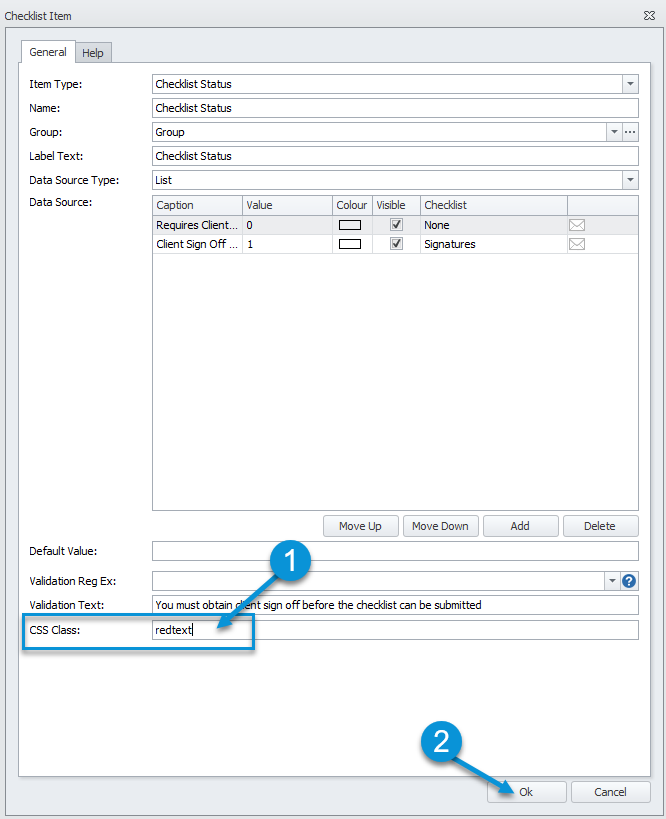
When the Mobile user completes the checklist the styles applied will flow through as per below:
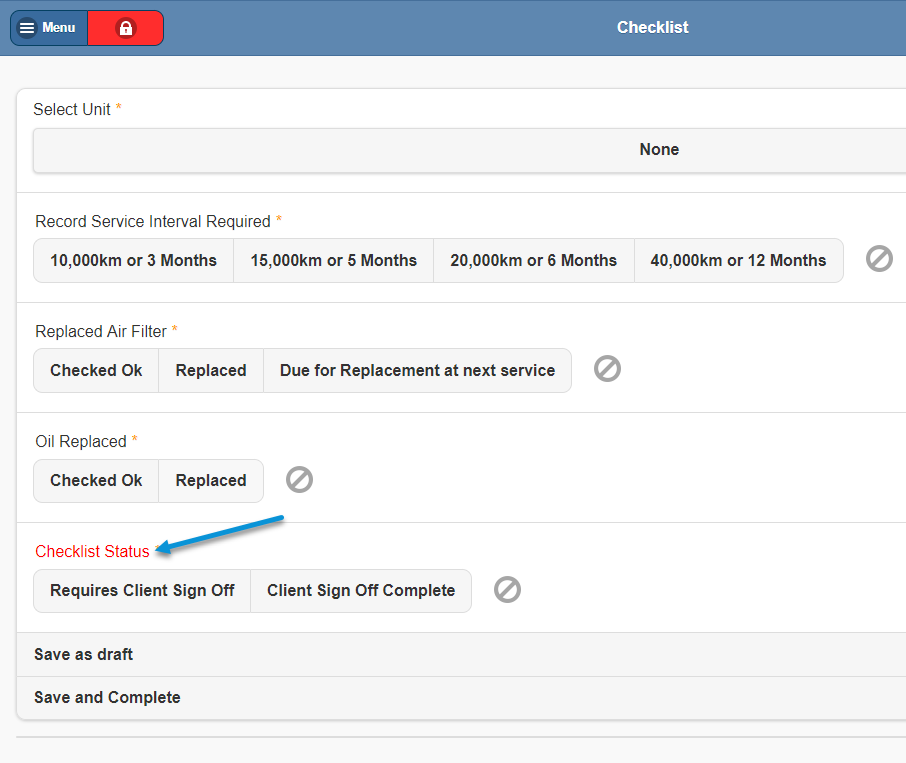
30. 3CX and TimeTrak Integration
3CX is an open standards communications solution (IP Phone system). In TimeTrak version 19.3 there is added integration, which provides the ability to assign an extension to a contact. Contact information can pop on incoming phone calls as per below:
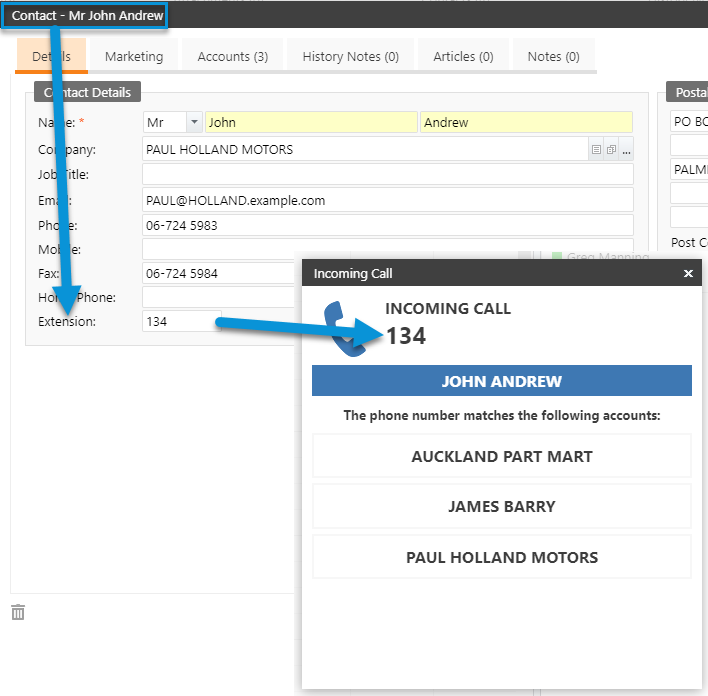
For more information on 3Cx integration within TimeTrak click here.
31. Changes to Time Sheet Verification and Multi Person Verification
TimeTrak Professional has verification reports that can be run by user or job that display all time and disbursements entered to allow a manager to verify and amend if necessary, prior to posting to ERP.
Please refer TimeSheet Verification by Job or User for more details.
In previous versions of TimeTrak, timesheet verification only allowed single user verification based on verification reports or group approvers. In TimeTrak version 19.3 onwards, the Time Sheet Verification feature has been enhanced with different user option functions for Multi Person Verification.
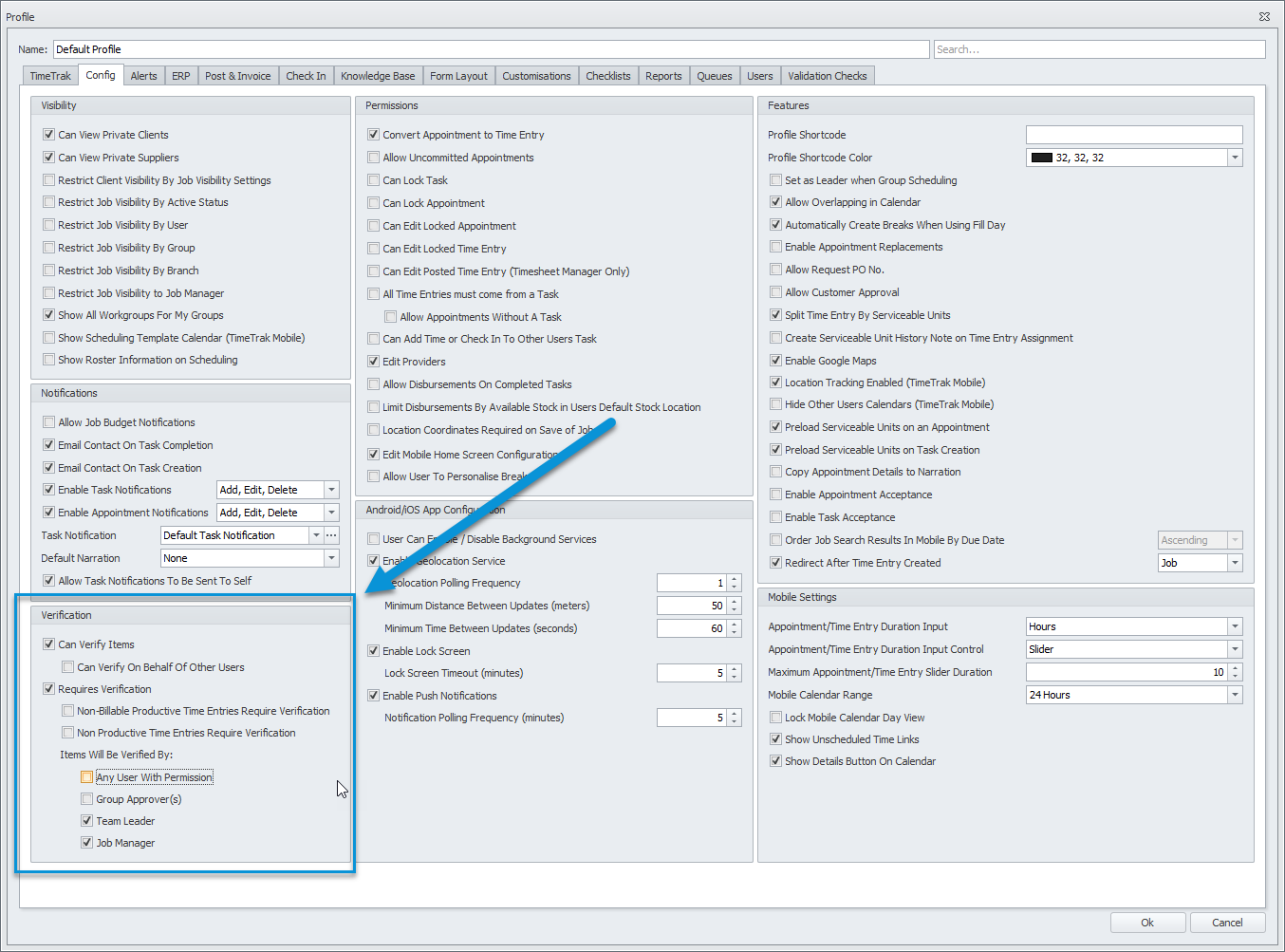
These settings are divided into two sections:
Section One:
1. Can Verify Items – allows the user within the profile the ability to verify time entries (e.g. Managers, Team Leaders, or Supervisor).
2. This setting enables the options Time Verification By Job and Time Verification By User in Professional.

3. Can Verify On Behalf Of Other Users will display a new option Time Sheet Verification Override in Professional.

Verification Signature – Whenever you verify an item, it will now show a signature of who verified the item. This information will flow through into the time entry activities tab.
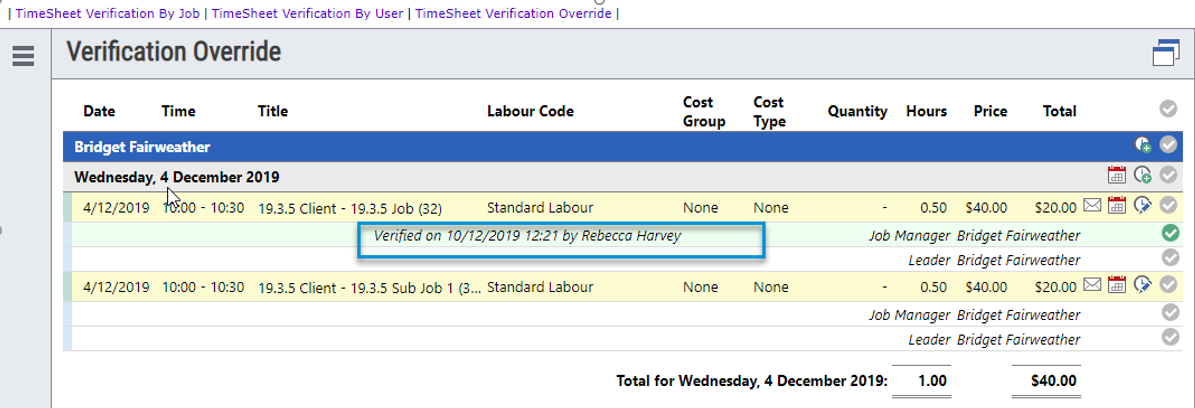
NOTE: By default, all Time Entries are automatically approved until you apply settings from Requires Verification.
Section Two:
1. Requires Verification – When activated, this setting makes all time entries unverified by default which allows the time verification process.
Non-billable time entries and Non-Productive time entries can be set to require verification like they have been previously, however they can now be excluded from requiring verification if these settings are not enabled.
As part of multi person verification there are four options to enforce who Items Will Be Verified By:
- Any User with Permission enables all users who have the profile setting “Can Verify Items” enabled to verify time. This is the previous timesheet verification behaviour.
- Group Approver(s) – Restricts the user to approve time entries for a set group people. This setting can be activated under the Groups tab of the Users and Resource/s in the Administrator Console
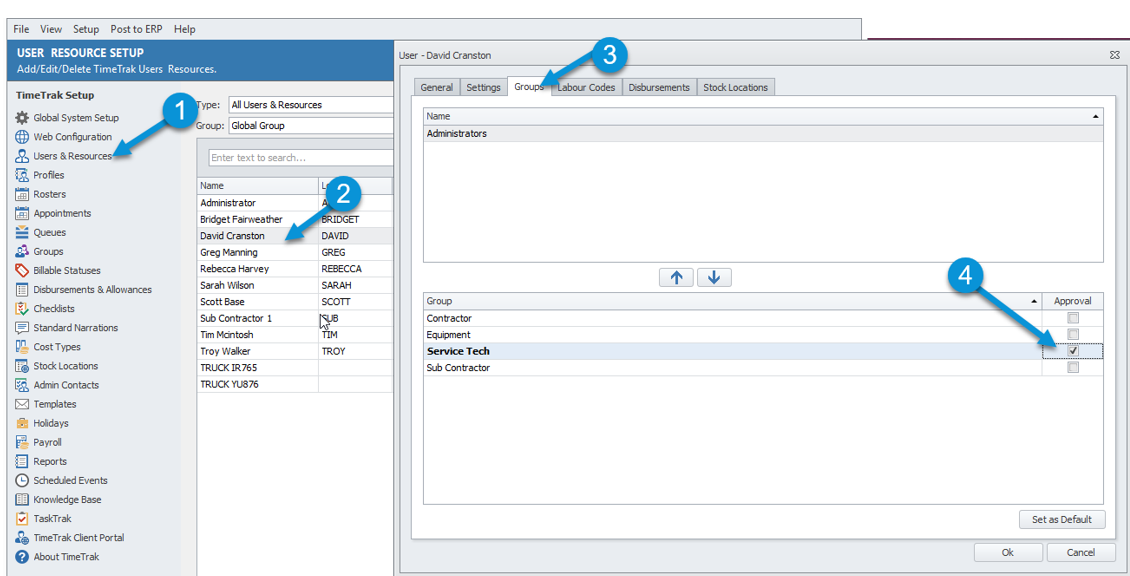
- Team Leader can be set up when you create group scheduling (Click here for more information).
- Job Manager – allows time entry verification for jobs when they are assigned as the Job Manager.
Once a time entry has been verified it is now marked as verified and the user is unable to edit the entry.
The new legend within TimeTrak displays the different stages of verifications
Legend Items
The fill colour of clock icon on the time entry is determined by the status of verification, this can be found under the legend listing as shown below:
White – the time entry hasn’t been verified
Yellow – the time entry is partially verified
Green – the time entry is fully verified.
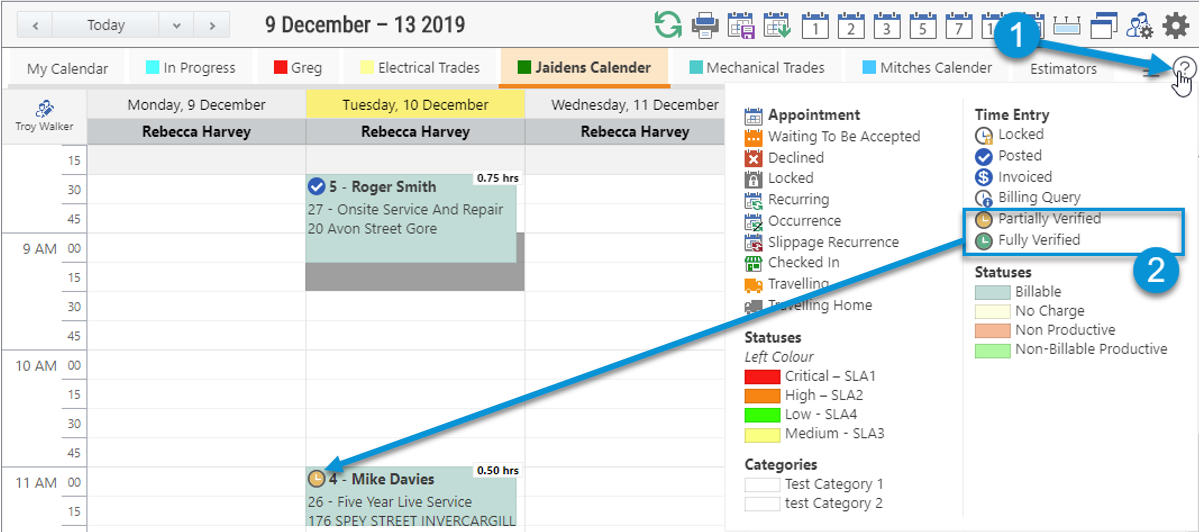
Timesheet verification is now also possible within TimeTrak Mobile to provide the ability for field staff including team leaders to verify time.
For more information on Time Sheet verification changes in 19.3 click here.